FRENCH GUYANA
EXPLORING HIDDEN JUNGLE FISHERIES
By Francois Bietry


EXPLORING HIDDEN JUNGLE FISHERIES
By Francois Bietry

By Helmut Zaderer
Building on a legacy of ruggedness and durability, the award-winning Vector Zip Stockingfoot Wader provides best-in-class abrasion and puncture resistance while enhancing the in-water fishing experience with a fully-submersible zipper entry and patent pending fishing features including a 360° pocketing and storage system.






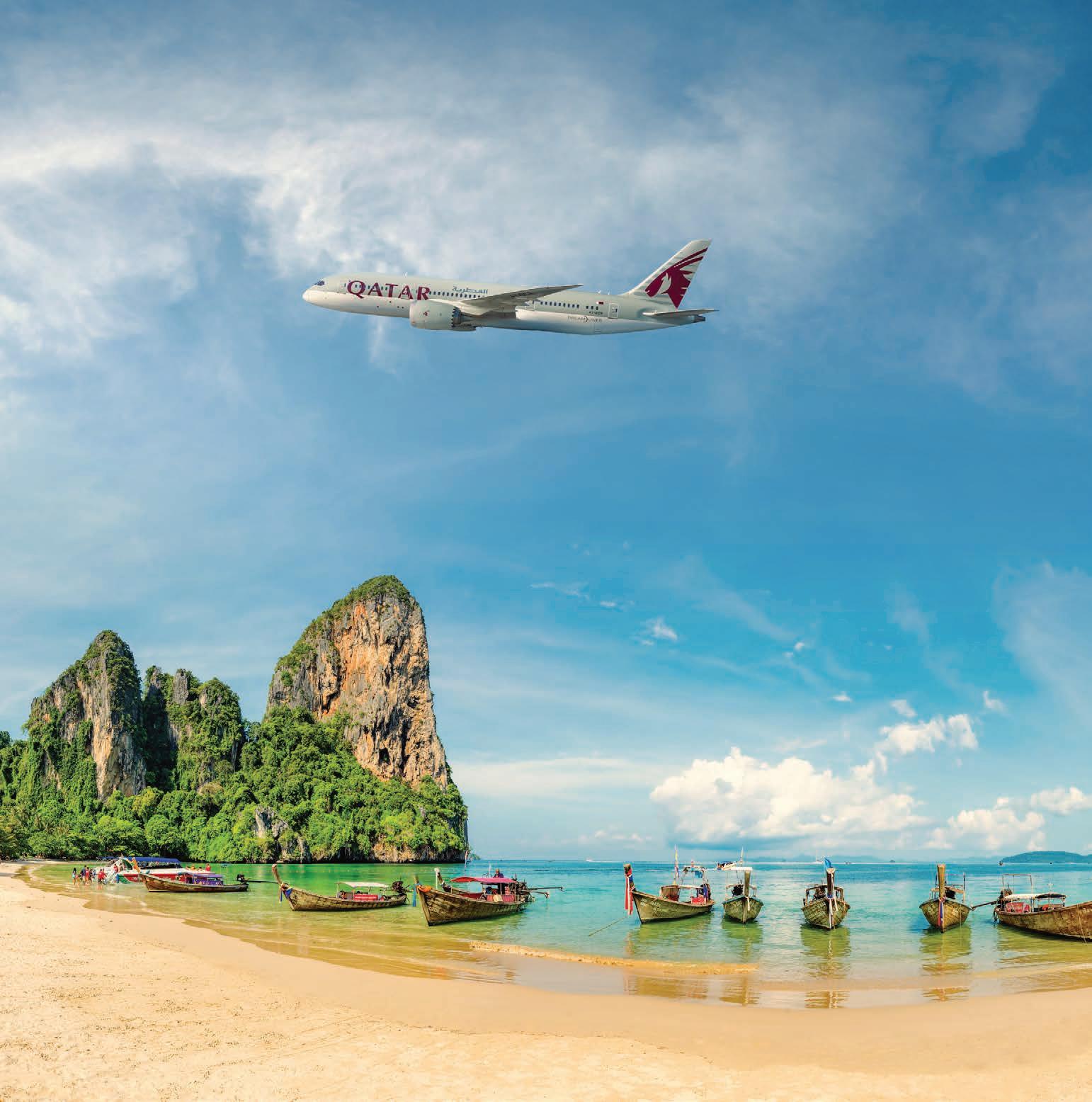
Spring is just around the corner! Isn’t that a great feeling?
In a world full of increasing uncertainty, it’s great to know that some things remain constant and dependable. Shortly, we’re off to Oman to flyfish for Indo-pacific and Africanus permit, but – rest assured – once we’re back, we’ll be all over our local waters. After all, that’s what spring fishing is all about!
There is something amazing about experiencing the altercations of the seasons and how they transition a place and sphere that – because of it – feels both intimately familiar and oddly foreign.
This time of year is always busy. However, if you can find the time to read our Spring 2025-edition, we’re sure you’ll enjoy it. It features great contributions from Keith Rose-Innes, Jakub Kanok, Chris Hrycyk, Gordon P. Henriksen, Columbus Leth, Helmut Zaderer, Vaidas Uselis, Felix Hansvencl, Alexis Pageau, Charlie Hicks, Francois Bietry, Peter Lyngby, John Petermann, Lars Munk, and many more…
Tight lines out there!



Exploring Hidden Jungle Fisheries by Francois Bietry
The Bonefish Destination by Christopher Hrycyk and Jakub Kanok
The Kayapó’s Legacy by Helmut Zaderer
A Unique Greenland Experience by Felix Hansvencl Rumble in the jungle by Gordon P. Henriksen
Chasing Golden Mahseer by Keith Rose-Innes
And much much more...




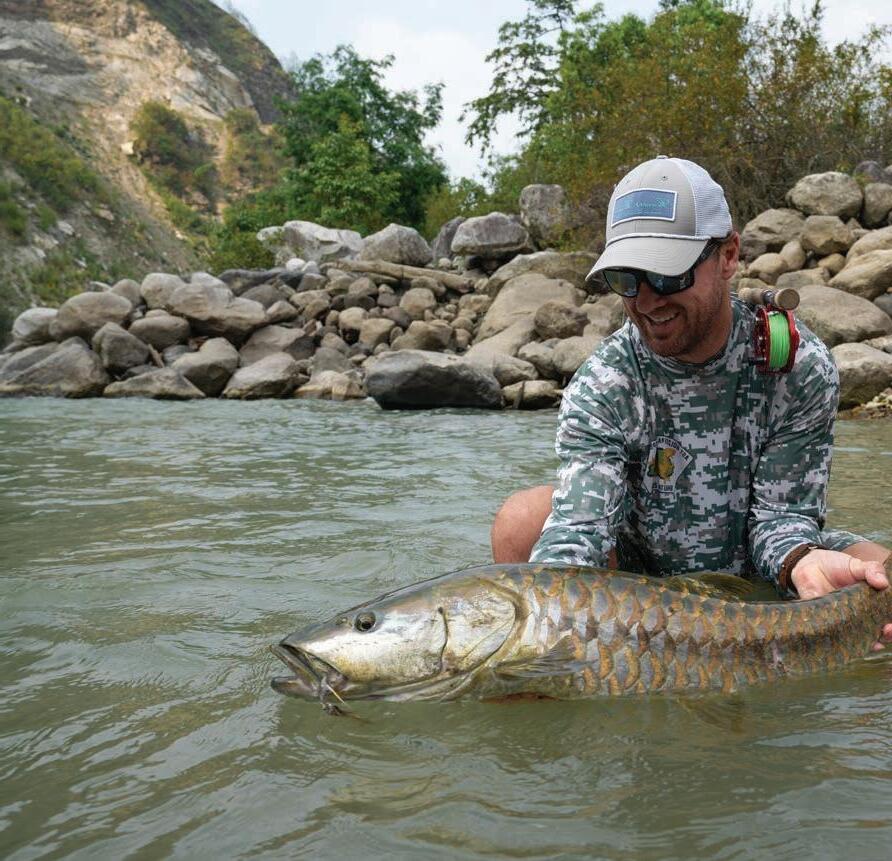



We choose not to print this magazine and we are happy not to use paper and harmful inks as used in a conventional printing process.
No portion of this magazine may be reproduced without the written consent of the publisher.
Oslo-resident, Rasmus Ovesen, was handed his first fly rod at the tender age of eight, and he has been a borderline fluff chucking fanatic ever since. Rasmus has written articles for some of the world’s most renowned fishing magazines,


Austrian fly fisherman and adventurer, Helmut Zaderer, has travelled the world exten sively with his fly rod. He is particularly fond of targeting the gangster of the flats in the Seychelles, but he has an open mind to any fishing experience as long as it involves wild fish in pristine environments and disarming natural- and cultural encounters. Helmut does a lot of hosted trips, and you can find out more about them by visiting his website: https://flyfish-adventures.com/

Born and raised in southern France, Francois Bietry is a pas sionate fly fisher, photographer, and full-time guide with nearly a decade of experience across France, Europe, and Patago nia. He is a Certified Casting Instructor (CI) with Fly Fish ers International and a Level 1 instructor with SIM Swiss.
Dedicated to fly fishing, river conservation, and education, he serves as vice president of AAPPMA, a non-profit promoting responsible fishing and environmental preservation among children. During the winter, he organizes fly-fishing trips in Chilean Patagonia, working closely with local communities. Francois enjoys sharing his exper tise with anglers of all levels, emphasizing skill development, envi ronmental awareness, and respect for aquatic ecosystems. When not guiding, he captures the beauty of rivers and wildlife through photography and filmmaking with his production company.

Christopher Hrycyk is an Aus tralian who developed a pro found interest in fly fishing at a young age following a trip to the Snowy Mountains in New South Wales. His enthusiasm for the sport intensified dur ing a 15-year residence in New Zealand, where he had the op portunity to explore its remark able lakes and rivers. After returning to Australia, he renewed his passion for saltwater fishing expeditions. Chris schedules fly fish ing trips whenever possible, frequently visiting remote locations in search of new species and challenges. When he is not engaged at his tying desk, formulating patterns for his forthcoming trips, he can often be found fishing on a river or flat.


os, or stories that you would like to share with our readers? If so, please don’t hesitate to get in touch with us. We are always looking for quality material for In the Loop Magazine, and we look forward to reviewing your material.
Felix started out in the sports in dustry, playing professional soc cer for Bundesliga clubs such as Eintracht Frankfurt as a young ster. After finishing his studies – a B.A. in International Sports Management and a B.A. in Inter national Business Administra tion – he was in charge of the In ternational Business operations for Eintracht Frankfurt. At the age of 25, Felix started doing hosted fly fishing trips to various destinations worldwide and - 5 years later - he decided to leave the sports industry and focus full-time on the destina tion angling sector. Since then he has worked as a travel agent as well as manager and guide for different lodges around the world, such as the Las Buitreras Lodge on the Rio Gallegos (Argentina). Photography plays a big role during his season and trips:

Gordon P. Henriksen is proba bly the most well-known fish erman in Denmark. He hosts a Danish fishing radio show and he is a tv-host on various pro grams on national Danish tel evision, National Geographic Channel, and Youtube. He is into most kinds of fishing, but he especially loves sight fishing and fly fishing in both Danish and foreign (warmer) waters. You can follow Gordon on Instagram: @Gordon_p._henriksen







w www.alphonsefishingco.com
t +248 422 9700 [GMT+04:00]
m +27 60 980 7316 [GMT+04:00 WhatsApp]
e reservations@alphonsefishingco.com





OUR
Alphonse Island | Astove Atoll | Cosmoled o Atoll | Farquhar Atoll
Amirante Islands | Providence Atoll | Platte Island
Experience the world’s best fly fishing with Blue Safari Fly Fishing, a specialised Seychelles based operator that has spent decades pioneering the fly fishing at these remote Outer Atolls. Our trips are designed to make all your fly fishing dreams come true by providing the best guides, skiffs, lodging and atolls with abundant waters full of trophy fish.
We’ve had the privilige of traveling to some of the world’s premiere fly fishing destinations. Now, it’s your turn! Browse Destinations





























After two years of waiting, I finally made the long-awaited expedition we’d been preparing for months with Yann, my childhood friend. In 2019, I came to visit Yann for the first time. He has been living in French Guyana for a few years now. As soon as he arrived, he told me about the jungle as he saw it: a dense, impenetrable forest with an unwelcoming appearance.
I remember seeing Yann’s vision evolve over the months and years he was there. I was discovering this country through his words, and the more time that passed, the more welcoming this forest seemed - if you approached it the right way. He would send me photos of spiders of all sizes, snakes of all colors, and incredible rivers. What at first appeared to be a green hell became an insider’s delight for those who liked bugs and humidity. Shortly afterward, he talked to me about the fishing.
Yann has always been a talented fly fisher and competitor. Minimes, Cadets and Juniors at the French Youth Championships, he has twice won the title of French Champion, and has landed in the jungle with the technical experience of a French competitor. Educated as a nymph on “A la roulette” (classic French nymphing technique).
He tells me that a mysterious fish lives in the black waters of Guyana’s rivers, a nocturnal carnivore with Pitbull snags and special forces armor. Hoplias Aimara.
But how do you catch this beast on the fly? Little information is available on the Internet, and the fish distribution is quite uneven depending on the river or creek where it lives.
The solution is to spend hours and hours on the water looking for it and trying to understand it.
After several years of living on the banks of the river marking the border with Brazil, Yann’s understanding of the behavior of this fish—thriving in waters that fluctuate between 100 and 140,000 ft³/s between the dry and rainy seasons—has become increasingly refined.


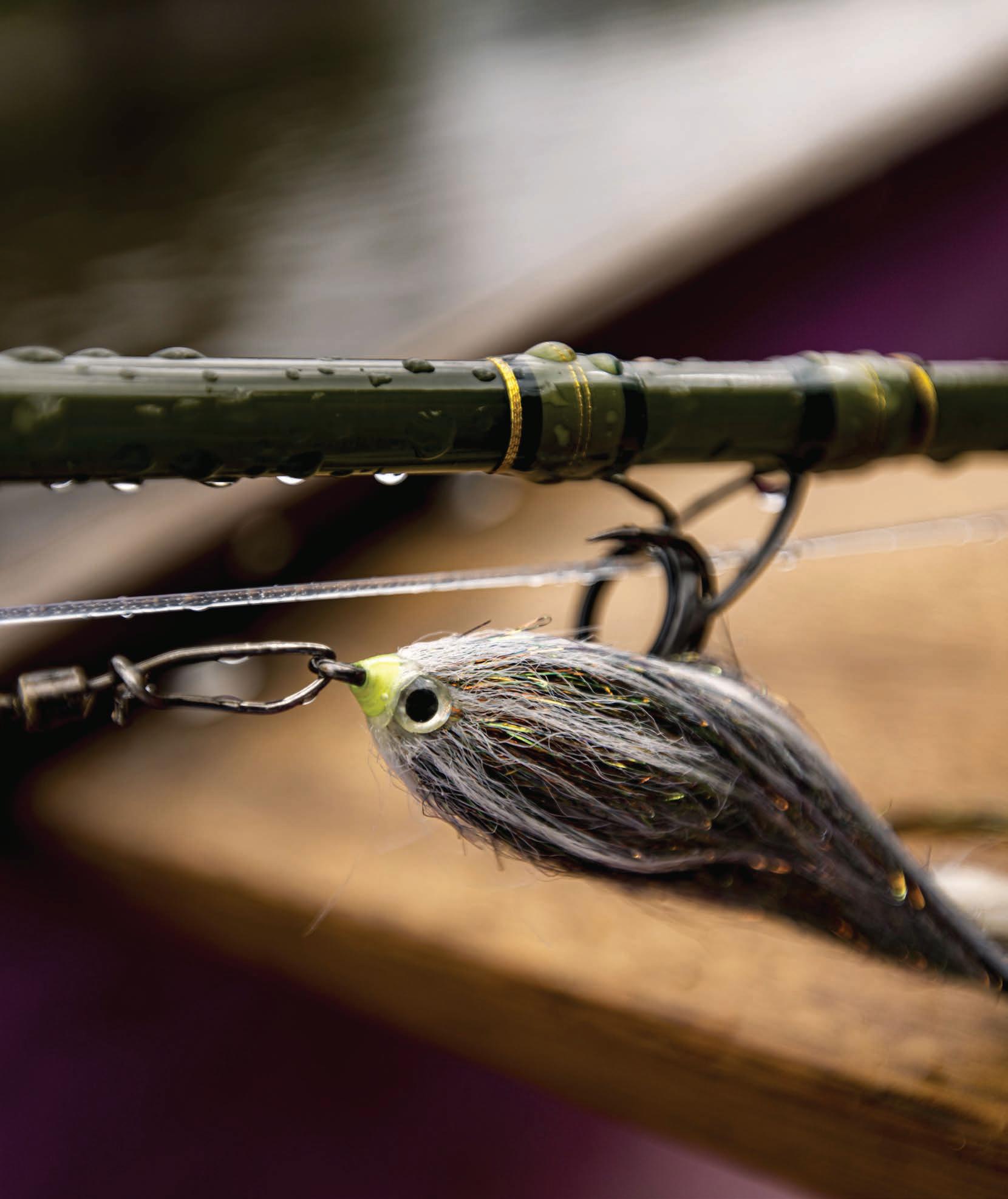





In November 2019, I finally flew to Cayenne with two 9-weight rods and a handful of big streamers. This long-awaited first trip was a mesmerizing introduction to the Amazon Rainforest alongside my friend, who had become an expert in bugs and knew his river like the back of his hand. I was fortunate enough to hook a few of his prized Aimaras on the fly, but my equipment was woefully inadequate against these black devils. The moment they took the fly, they had only one goal: to retreat into the depths, weaving through the sharp granite boulders where they dwell.
Fast forward to December 2023. This time, with a much clearer idea of what awaited me in the jungle, I set off armed with a 7’9” 12-weight fiberglass rod—painstakingly built on a Rodhouse blank by my friend Laurent Keiff. A philosopher, rod-builder, madman of a caster, and an incurable blank geek, Laurent and I had a long discussion about my needs, the brutal fishing conditions, and the sheer force the rod would endure. Then, with a knowing grin, he told me about this atypical rod:
“So,” he said, “it has the diameter of a supermarket neon light, could lift a donkey without breaking a sweat, and the Spanish guys are landing 2-meter catfish with it.” Perfect!
Between sips of Cuban rum at the legendary Black Sonata bar in Argentat-sur-Dordogne, I placed my order: a heavy-duty reel, an intermediate line tough enough for GTs, and a batch of monstrous streamers. Then, once again, I was off to Cayenne.
This time, Yann and I embarked on a 12-day self-sufficient expedition aboard a fiberglass Mouchalagan—a traditional Canadian canoe. Our plan: paddle across the largest lake in French territories, then push several kilometers upstream into the river.
Averaging 30 km per day with our canoe fully loaded, we reached our destination on the fourth day of the journey. As we cracked open our last two cold beers, it was finally time to rig up.




Taking no chances, I carefully replaced the loop on my fly line with a several-centimeter-long homemade ligature—advice from a friend who likes to pull very hard when he’s hooked into a GT.
A 130-pound test fluorocarbon leader, 80-pound steel cable, a rolling snap, and finally—the masterpiece: a Magic Carpetstreamer, as big as a giant’s hand, mounted on a 10/0 hook and armed with a gleaming willow leaf spinner nestled among its flashy fibers. The sharp pop of a Saint-Émilion Grand Cru cork echoed through the jungle, marking our arrival. The cooler still guarded the last fresh meal of our journey: duck breast with pommes de terre sarladaises, sizzling over the fire—a well-earned comfort for our soaked and weary souls.
At the crack of dawn, barely in bed and already up, rods rigged and streamers sharpened, Yann took the helm of the canoe as we set off toward the lower Saut—the local term for a rapid. Standing at the bow, I launched my streamer with all my strength, aiming for the base of the granite chaos where the river foamed. Just a few casts in,
I nearly had the rod ripped from my hands the instant the fly hit the water. Stunned by the sheer violence of the strike, I set the hook too early—missing the first fish of the trip.
After some cursing and a deep breath, we pulled up onto a massive boulder in the middle of the Saut, deciding to weave our way upstream, searching for pockets to slam our streamers into.
Balancing on a half-submerged log, Yann suddenly lost a massive fish… Aimaras can reach up to forty pounds, with the French Guiana record standing at 18 kg. Frustration gave way to renewed focus. I reached a promising spot, braced myself for impact, and fired my streamer between two enormous boulders at point-blank range. Before I could even begin my first strip, the fiberglass rod bent hard— right into the handle.
“Yann!” I called out. “Net! Two meters below!”
After a titanic struggle—jumping from rock to rock—Yann managed to land the first Aimara of the trip.







That’s it! Box ticked.
A feeling every traveling angler knows well: the relief and satisfaction of the first catch. Now came the tricky part. The Aimara’s jagged teeth clamped down on the shredded streamer, making it clear that sticking our fingers in its mouth wasn’t an option. Piercing it with a boga grip?
Out of the question. Instead, much like handling a northern pike, a delicate grip under the gill plate ensured a smooth and injury-free release of this prehistoric beast. After a few quick photos, Hoplias returned to its submerged granite lair.
Over the next four days, we landed a series of magnificent Aimaras in these rapids. Torrential rain, soaked hammocks, and military rations became the rhythm of our days, as we paddled deeper into the wilderness, pushing further with each outing.
A couple of days passed, and life out here felt good. We had become comfortable slaloming through the boulders of our home rapid, but soon,
that itch for the unknown returned. With the last sliver of battery on one of our phones, we scoured an offline map for a new challenge. We found one: a remote stretch of water 53 km upstream, past several white-water rapids that we’d have to ascend before making the long paddle back down.
A four-day minimum of hardcore upstream travel. Limited food. High risk. We looked at each other, weighed the odds, and settled on a simple plan: let’s not die this time. Instead, we found another promising spot, much closer. It was time to pack up and prepare for a day trip into the unknown.
Our last ice cubes had long since melted, along with the last of our cold beers. The luxury adventure was officially over. Now, we’d have to ration our food carefully and get creative if we wanted to eat anything other than military rasquette—a dehydrated beef-and-carrot dish gifted to us by Russian legionnaires (but that’s another story).





It was humid, as always, but strangely, we were getting used to it. Our provisions were running low: a few potatoes, some rice, pasta, peppers, spices, and the last vacuum-sealed piece of chicken, which was beginning to warm up in the heat.
On the morning of the ninth day, after a quick coffee, we set off to explore a tributary that joined our river downstream from camp. A blackwater creek, winding through a labyrinth of submerged dead trees. Massive granite boulders, weighing several tons, fragmented the river, carving out tight meanders.
By 4 p.m., with nightfall only two hours away, we were still deep in the unknown, two hours of paddling from camp. But turning back now wasn’t an option—not before seeing the source of the roaring we could hear deep in the forest. The whitewater’s tumult blended with the guttural howls of monkeys and the piercing cries of birds, a deafening, primal symphony.
Navigating upstream became increasingly treacherous. Submerged trees slowed our progress to a crawl. At times, we had to flatten ourselves inside the canoe, squeezing beneath low-hanging branches, praying we wouldn’t snag on an invisible stump and capsize. The decaying logs were thriving nests of biodiversity—tarantulas, toads, snakes, and all manner of arachnids made their homes here. We moved cautiously, watching where we placed our hands as we clung to the drenched trees for support.
The birdsong faded, drowned by the growing roar of rushing water. The current became too strong to paddle any further. It was time to pull the boat to safety. Waist-deep in water, we dragged the canoe onto a narrow patch of beach, securing it before continuing on foot.
5 p.m. Yann grabbed the ready-togo 12-weight rod and waded ahead toward the next bend. I opened my Peli case, my waterproof fortress for camera gear, eager to capture the thickening fog rolling over the water. “I’m going to check up ahead,” Yann called over his shoulder, already waist-deep and nearly out of sight. “I’ll stay here for some shots!” I replied.
And just like that, I was alone.
Feet sinking into the black earth, camera in hand, I looked up toward the still-white sky. A delicate mist curled off the river’s surface. Time seemed to stretch and dissolve. I lost myself in the eerie beauty of the moment, composing frames—first with the 200mm lens, then switching to macro, and finally wide-angle.
I wandered along the water’s edge, my eyes scanning for movement— frogs, insects, lichens. I hoped to spot a snake, its patterned body weaving through the undergrowth, a perfect subject for my lens.
Time slipped away, impossible to measure. Eventually, I made my way back to the boat, expecting to find Yann waiting. But he wasn’t there. Dusk was settling in. The soft, fading light told me it must be close to 6 p.m.
I called out, “YANN!” My voice echoed through the trees. Silence. I whistled once. Then again. Nothing. I knew the man well. But caution was key. I took a moment to prepare. I packed my bag—headlamp, satellite phone, camera, water, snacks, machete, first-aid kit. Then, I settled into the boat, feet stretched out, opening a book. And waited.
I say to myself: 5 pages, and if he doesn’t show up with the happy face of having discovered a new piece of water, I go up to look for him along the river.


A moment later, I realize I can barely see anymore—damn, the book was too good. I must’ve read at least twenty pages. Snapping back to reality, I stash the book inside the Peli case, tucking it under a pile of leaves. I pull the boat further onto the shore, securing it properly. Then, I switch on my headlamp, grip my machete, and step cautiously into the forest, following the river’s edge.
“YANN!” Nothing. The roar of the rapids grows louder as I push into the undergrowth, where the jungle has already swallowed the last traces of daylight. The only illumination comes from my headlamp bouncing off slick leaves, reflecting the ghostly white foam of the churning water below. I hope he didn’t fall in.
I hack my way through vines and dense-leaved shrubs, fighting the resistance of the jungle, when suddenly—I stumble onto a well-marked trail. Odd.
tween roughly cut trees, revealing the remains of a makeshift shelter. I freeze. Listening. Silence.
I take a slow breath and continue forward, scanning the river below, hoping to catch a glimpse of Yann’s red life jacket amid the chaos of granite boulders. And then, that feeling. That precise, primal sensation of heightened awareness. The beam of my headlamp sweeps over the narrow path, revealing a carpet of damp, brown leaves and twisted roots that make it impossible to move quickly. A creeping thought surfaces: What if…?
A few hundred meters in, I come across what looks like an abandoned campsite. Torn tarps hang limply be-
A flood of dark possibilities follows, scenarios with tragic outcomes. But I shake them off—now is not the time for distractions. Fear leads to hesitation, hesitation leads to mistakes. And mistakes, out here, could kill us. Focus. Stay alert. Keep moving. A few hundred meters further, something massive shifts beneath my feet—a black snake, thick as my wrist, slithering away before I can identify it. My heart pounds, but I press on. Then, another wild camp appears. Same drill. I stop. Listen. Nothing.



Cautiously, I step under the tattered tarps. The remnants of life are scattered around: old gasoline cans, empty bottles of cheap whisky, a splintered table with an ashtray perched on top. The scene is straight out of a horror movie.
“YANN!” I call out again, this time louder. A pause. Then - “YES!” Relief floods through me.
I quicken my pace, stepping into a clearing where the last shreds of daylight filter through the canopy. And then I see him—Yann, emerging from the jungle, soaked to the bone, grinning like a madman.
“Man! I climbed into the waterfall and watched a wolffish swim upstream like an Atlantic salmon!” he shouts, breathless with excitement. I laugh, exhaling the tension I hadn’t realized I was holding. He has no idea how much pressure had built up since I closed that damn book. A natural threshold in the river creates the perfect fishing spot, and within minutes, Yann hooks into something—a rare white Aimara. We stare, mesmerized by its pale coloration, its ghostly presence in the dark waters. Then comes the question: Do we eat it?





It’s a good six kilos—too much for one night, and by morning, it won’t be fresh. Letting it spoil would be a waste. With one last look, we release the Aimara back into the blackwater, watching it disappear into the depths. Time to head back.As we navigate fallen logs and tangled roots on the way to the canoe, I joke, “You did scare me a little back there.”
Yann grins. “Oh yeah, I know. Sorry… but it was too beautiful—I couldn’t stop.” I get it. I probably would’ve done the same.
On the paddle back, we take the opportunity to gather the driest wood we can find for the fire. The journey is slow, retracing our route through the twisting tributary, then hauling ourselves a few hundred meters upriver to camp.
10:00 p.m. “Beer?” I ask. Bad joke. We’ve been drinking lukewarm river water for four days, and to make matters worse, our mosquito repellent leaked into the Katadyn filter— our only means of purifying water. The result? A nauseating cocktail
of stale canteen water, lemongrass, and chemical repellent. Well, what’s for dinner?
Fire, Feast, and Farewell
The plan had been to talk about cooking in the jungle—but first, we had to survive it.
To cook, we needed fire. And that’s not always easy in the heart of a tropical rainforest. But this time, we saw it coming—our stomachs had been protesting for too long to forget the essentials. Dry wood had been gathered along the way, and now it was time to put it to use.
Yann took charge of the fire. He crouched low, methodically feeding the flames, coaxing them to life. The scent of burning wood mingled with the damp, earthy air as I sliced peppers, catching glimpses of him between each careful cut. There was an unspoken rhythm to it, a natural balance between us. The perfect team.
The chicken was sliced into thin strips, the sweet potatoes into small cubes. The peppers, both mild and fiery, were cut into long, thin slivers.
A blend of salt, black pepper, and cayenne dusted the ingredients, followed by a drizzle of olive oil and a shake of cumin. Lime zest curled in fragrant shavings over the mixture, followed by the sharp burst of its juice. A final touch of honey softened the heat, and with that, the dish was left to marinate while we sipped on a wellearned Planteur—aged rum with ginger, brown sugar, and half a lime squeezed in for good measure. The cups clinked, a toast to the day’s adventure, the jungle crackling with unseen life around us.
When the wok hit the fire, the heat sent oil sputtering into flames, bursts of gold and orange dancing in the darkness. The aroma of searing spices filled the air, rich and heady. Flames illuminated the forest, flickering against the trunks of ancient trees. As the food browned, we raked the fire aside, creating a small bed of embers to let everything cook slowly.



Leaning against a tree, bowl in hand, the first bite was pure relief. The warmth of the dish, laced with lime and smoke, settled deep. Another sip of Planteur followed, the burn of the rum grounding us. Above, the Milky Way sprawled across the sky, untouched by the glow of any city, a vast and endless sea of stars. Another day came to an end.
With our provisions nearly exhausted, reality set in: it was time to leave. After ten and a half days, Mouchalagan was loaded with our remaining supplies and a few personal belongings. We pushed off from the shore, paddling away from the place that had, however briefly, become home. This time, we were in no rush.
Instead of following the most direct route back, we extended the journey by another forty kilometers, hugging the mainland, slipping into forgotten streams, exploring pockets of jungle that had likely not seen a human face in decades. The forest moved around us, alive in ways we
could only witness from the edges. Scarlet macaws cut across the sky in flashes of red, while Atele monkeys launched themselves effortlessly through the canopy.
Capuchins observed us from a distance, their quick, darting eyes filled with mischief. Howler monkeys let out their guttural cries, shaking the air with each deep-throated roar. Heavy tapir tracks pressed into the mud reminded us that we were only visitors here.
And always, somewhere beyond our line of sight, there was the ultimate predator. The Jaguar. We knew he was there. Watching. Deciding. But he never revealed himself. Still, his silent presence was enough to remind us of where we stood in the hierarchy of this world.
Out here, there were no distractions, no noise, no endless notifications—just the forest, the river, and the rhythm of our own survival. No pollution. No signal. Only presence. The jungle set the pace, and, with quiet reverence, we followed.







F ROM OCEAN TO RIVER, FROM CITY TO WILD − WE’VE BOTH MADE IT HOME.

E very journey leaves its mark — on flanks of chrome, on worn in wading boots — on souls. But when you finally reach a place that feels like home, all the miles fall away and everything that matters comes into focus. You get one life. Fish It Well.


I had arranged a visit to the Cook Islands about five years ago, but a move overseas scuttled those plans. My mate Jakub had fished in the Cook Islands numerous times and his stories of Aitutaki bonefish were a constant tease, and although we talked about doing a trip together, no solid plans were ever made.


When a bonefish trip to the Bahamas fell through, I impulsively booked accommodation and flights all the way to Aitutaki, sent Jakub my itinerary via WhatsApp and hoped for a positive reply. Within minutes Jakub had called, his first words being, “bro… are you serious, you can’t do that to me, you can’t go without me”.
The next few months saw long-distance chats about flies, guide options, locations and everything fishing mates mull over when a big adventure is on the horizon. And then, almost like a dream, we found ourselves transiting through the city of Auckland. As I walked to meet Jakub at one of the airport bars it dawned on me. This was it. I’d be in the Cook Islands in a few hours.
Hearing the roar of reverse thrust and feeling powerful brakes start to slow the aircraft, made our anxiety levels drop to a minimum. “Flight attendants disarm your doors”. What a pleasure for the ears. No, we are not afraid of flying. But with two flights returning to Auckland Airport just a day before our departure day due to bad weather conditions in Rarotonga causing crosswinds, the relief to touch the ground in the Cook Islands was real!


After clearing passport control and collecting our baggage we carried straight on through to drop off our gear for the next connecting flight to the Outer Island of Aitutaki. With a couple of hours up our sleeves, we quickly found ourselves at the Hula Bar, Rarotonga’s iconic all-day everyday happy hour place. From August to September, humpback whales can often be seen from the foreshore. The whales come from Antarctica to the warmer waters of the Cook Islands to mate and calf, but I never expected them to put on a show right in front of the bar deck overlooking the ocean while sipping a green bottle.
Kia Orana!
“Welcome to the beautiful Island of Aitutaki”! The air suddenly got heavy with the fragrance of Tiare Maori and Tiare Teina (Gardenia) flowers as Garlands were placed around our necks by our host Sally who Jakub immediately recognised from his previous visits. Shortly we found ourselves at the doorstep of our accommodation. Sally even organised a couple of 110cc scooters
ready to be used and abused. All we needed was to pick up bonefish permits the following morning.
A little paradise is what Aitutaki is, home to approximately 1800 people and the world’s most beautiful lagoon. It’s only a 45-minute flight from the main Island of Rarotonga. Secluded and romantic,15 islets are sprinkled across this huge turquoise, sunlit lagoon. The crystalline waters hold some of the largest bonefish found on earth. Our playground for the week. They looked as good as I had hoped. I glanced at Jakub and saw that he was pretty rapt. No doubt because he knew what was in store for the week ahead.
We caught up with his friend and our guide Butch Leone from Aitutaki Blue Lagoon Fly Fishing. Butch expounded the merits of one fly, the yellow Clouser, and carried only three flies whenever out on the lagoon, all “Clousers in various states of disrepair”.










Boating around the lagoon on Butch’s skiff revealed the undeniable beauty of Aitutaki. The water was so clear and intensely vivid blue, the sandy beaches, flanked by dense coconut forests, were pure white. Absolute paradise.
We got into some nice bones straight off the boat on the first flat we anchored off. Large schools cruised in from our left, and both Jakub and I hooked up to some hefty fish on those trusty yellow Clousers.
The thrill of a bones first run is hard to express in words - it was an exhilarating and satisfying experience. As quickly as these fish entered our world they were gone. As we waded, straining our eyes to see a shape or flash of silver, an hour passed without any further success.
Butch suddenly gestured towards a large black shape moving across the shallow flat in the far distance. Big GT, he shouted! I noticed that Jakub had already started to move into a better position, his eyes locked on the target. His cast was on the money to the fast-approaching fish and after a strip or two, the beast charged and devoured his fly. The fight that ensued was violent!


The power and speed of the massive fish were frightening and as it headed towards a reef about 150m out, we could only hope Jakub would turn its head. Watching this alongside Butch we wondered at what point his rod was going to explode to pieces. I have never seen such a solid bend in a rod before. Jakub was doing all he could but, it was not to be. The tension on the backing disappeared and we were left only with those lingering questions fishermen ask after losing a big fish.
“The power and speed of the massive fish were frightening”
These fish are difficult enough on a heavy popper gear, a fly rod of any sort is just asking for trouble. More wading brought us to the very tip of the flat and as I strained to spot bones I spied three large shapes over my left shoulder. A short quick cast saw me connect to the leading fish. The take was subtle, the tussle was anything but. As I drew my
prize closer to my feet Jakub tossed out his fly which was nailed straight away, a double hook-up.
Thoughts of the lost GT quickly evaporated as we fought and landed our fish. A pair of beautiful hard-fighting Island trevallies! The following days of fishing were great by any standards, however, Jakub and I sensed that apart from a few fleeting moments, the flats had been subdued and the bones few and far between. We had worked hard for the fish we sighted and successfully landed.
Despite bringing a combined total of 7 rods and 6 reels between us, gearing up for a flats trip to Aitutaki is a pretty simple affair. We took a pair of 8,9 and 10-weights with a 12-weight thrown in for the Geets.
9 weight rods are the perfect allaround rods when finished off with a quality silky smooth saltwater reel. These were spooled with 250 meters plus of backing and floating intermediate lines.







The sinking tips got the flies down where the bones were and also meant we did not have to go too heavy with our flies, which kept casting all day fun.
Leader suggestion is straight 16 to 20-pound fluorocarbon or a tapered leader/tippet set-up. Straight fluoro just meant less chance of something breaking during a fight. Flies are a personal choice, but anything gotcha-like in tan or sand, sizes 4 through to 1 would do the trick. Some might laugh at yellow Clousers but they really did outfish any other fly on this trip.
The island offers multiple spots where you can hide from the harsh elements, still get some good fishing donem and increase your species count. If the winds are making it difficult for you, I would suggest moving to the other side of the island which will be most likely protected.
fish nursery and spawning areas. If you intend to fish those you must be accompanied by a licensed guide.
All non–Cook Islanders who wish to fish in the Aitutaki and Manuae lagoons and surrounding reefs are required to obtain a Visitor’s Lagoon Fishing Permit. The cost of NZD 50 currency will get you a valid permit for a week, or a donation of $500 will see you with a lifetime lagoon permit.
Monday brought thunderstorms, heavy rain, flash floods and gusty winds. A perfect day to work on the vice and catch up over tumblers of rum. As the rain beat down on the thatched roof of our bungalow and the rum warmed our bellies, we talked about how once this storm had cleared the fish would fire.
Water taxis and kayak hire all exist on the island and will get you to a variety of places. The Lagoon has two bone-
With the swell, wind and cloud lingering after Monday’s storm, another DIY-day on the flats was in order. We found the flats teaming with bait fish, turtles and definitely more currents moving through.


Some nice bones were landed and many more were spotted and spooked.
Had the storm brought the fish on? It seemed so to me and Jakub only confirmed that this had happened to him a few times in the past. As we sat sunkissed and satisfied at the iconic Boatshed Bar & Grill after a great day on the flats, we discussed plans for the following day on the Island. The weather forecast looked OK - albeit not great - would we wake up to gusty winds, chop and clouds?
A phone call to Butch confirmed he was keen to head out again – definitely a good sign.
The boat ride to One Foot Island was a little quiet, reality had dawned, yes, we would soon be on a flight back to our respective responsibilities. A quick swig of rum however proved a tasteful reminder that right here, right now, we were still on a fishing holiday.






Wading slowly across the long sand flat I caught a glimpse of a bone at about 40 feet out in shin-deep water. As I lengthened my cast, I saw another, then another and another...2 strips after dropping the one and only Yellow Clouser as gently as possible I was on.
“What I thought was the shadow of a passing large cloud suddenly changed direction”
Playing with my fish, what I thought was the shadow of a passing large cloud suddenly changed direction - the shadow was in fact an enormous school of bonefish. Trying not to spook the school Jakub placed a cast onto the outer edge of the group, and with a strip he too was on!
And, like so many fishy stories where the unbelievable is true and the unlikely happens, as if to tease us, our last days on Aitutaki were also our best - warm gentle breezes, bright clear conditions with schools of bonefish all over the place. I could see now why this place does have a special spot in Jakub’s heart and all the reasons why he keeps returning.


Visiting Kendjam feels like stepping back in time 100 years. The experience here is one of the most overwhelming things an angler can encounter. It’s not just about the fishing—it’s the jungle, the wildlife, and the native culture that make this place truly special.

By: HELMUT ZADERER
Photos by: VAIDAS USELIS


The owners describe Kendjam as a premium jungle lodge—and honestly, I couldn’t find better words to describe this comfortable oasis in the middle of nowhere. It’s the perfect blend of wilderness and what I’d call luxury glamping, an experience that is nothing short of amazing. The food, the service—everything is a solid ten out of ten.
From the moment we arrived at Manaus Airport, we were warmly welcomed by Debora, who took us to Hotel Juma in the center of Manaus. That evening, we enjoyed a first-class dinner together before preparing for the journey ahead. The next morning, Debora accompanied us to the private airport, where we boarded a flight deep into the Amazon.
Upon landing on the remote airstrip at Kendjam, we were greeted enthusiastically by our guides and a delegation of Kayapó people. The honor of meeting Beprere, the community’s headman, was a humbling experience. From there, we embarked on a two-hour boat journey down the breathtaking Iriri River before arriving at the lodge. We were wel-
comed with drinks and snacks, and our guides gave us a tour of the facilities. The lodge was stunning, and from the first moment, we felt at home. The day ended with the usual routine—unpacking, organizing our gear, and preparing for what lay ahead: our first day of fly fishing in this untouched paradise.
One of the main purposes of this adventure was to produce my new film, KENDJAM. Unfortunately, my friend Vaidas got held up at customs and missed our flight into the jungle. For a moment, we joked that he might have to rent a canoe and paddle his way to us. Luckily, he was picked up separately and arrived a day later. Good thing, too - because our iPhone videos wouldn’t have come close to capturing the stunning quality of Vaidas’ professional photography and filmmaking. We were relieved when he finally made it!
The fishing season at Kendjam begins in mid-to-late June as the Iriri River recedes, with water levels continuing to drop through the late season in mid-September.






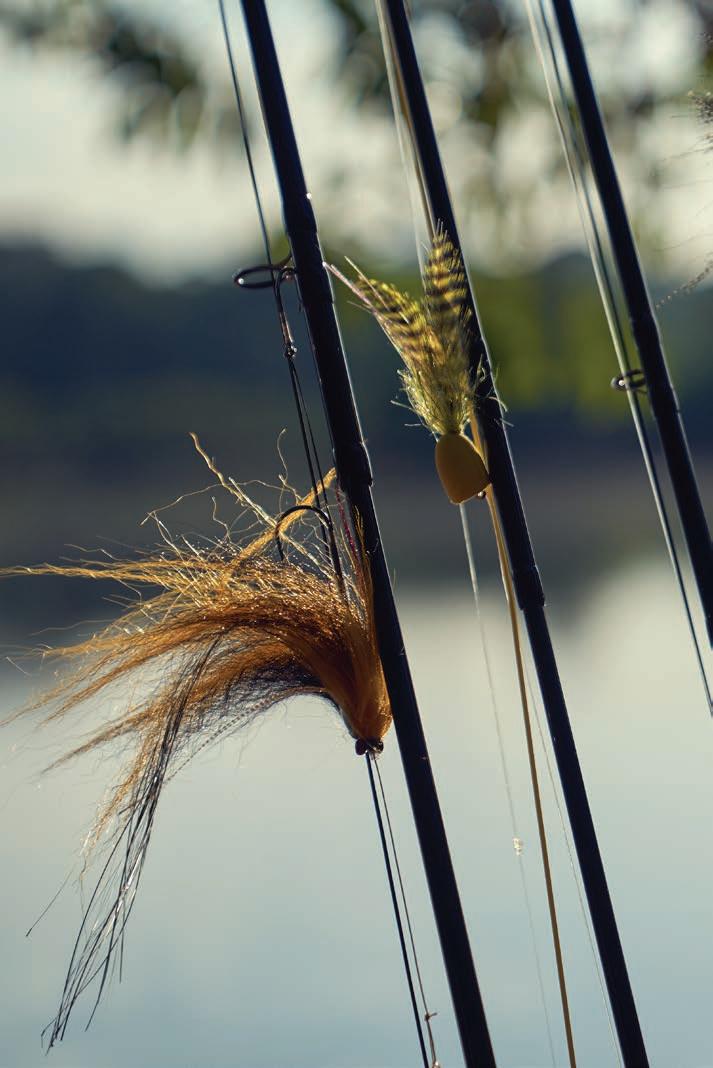

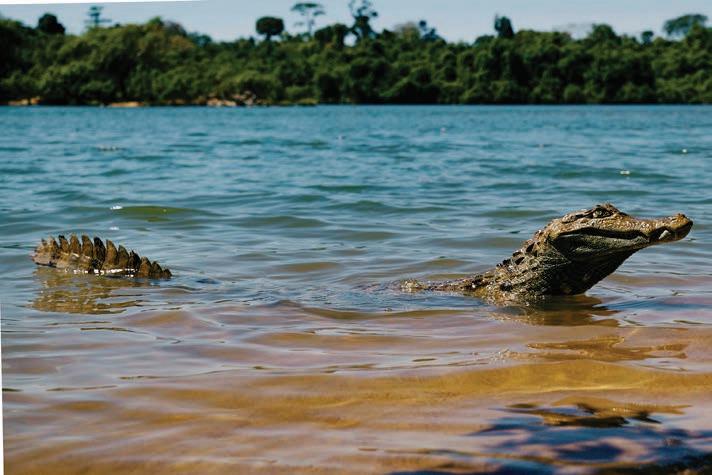
We chose the golden middle, arriving on July 16th. By this time, the river was shallow enough for easy wading, making it the perfect setting for sight fishing for peacock bass, matrinxã, pacu, and many other species. We were able to wet wade in most areas, gaining access to jungle creeks, shallow flats, and prime fishing runs.
We knew before arriving that Kendjam wasn’t a destination for giant trophy fish, but the Iriri River is a dream for any angler who loves crystal-clear waters, light fly-fishing tackle, and technically demanding fishing. The variety of species is incredible, and our main focus was sight fishing with dry flies—the ultimate thrill in this region.
Every day, we caught seven to eight different species. The Iriri River holds at least three known species of pacu, a fish that leaps out of the water to feed on insects. We targeted them with dry flies, wet flies, and nymphs, fishing upstream while wading with 5-weight rods.

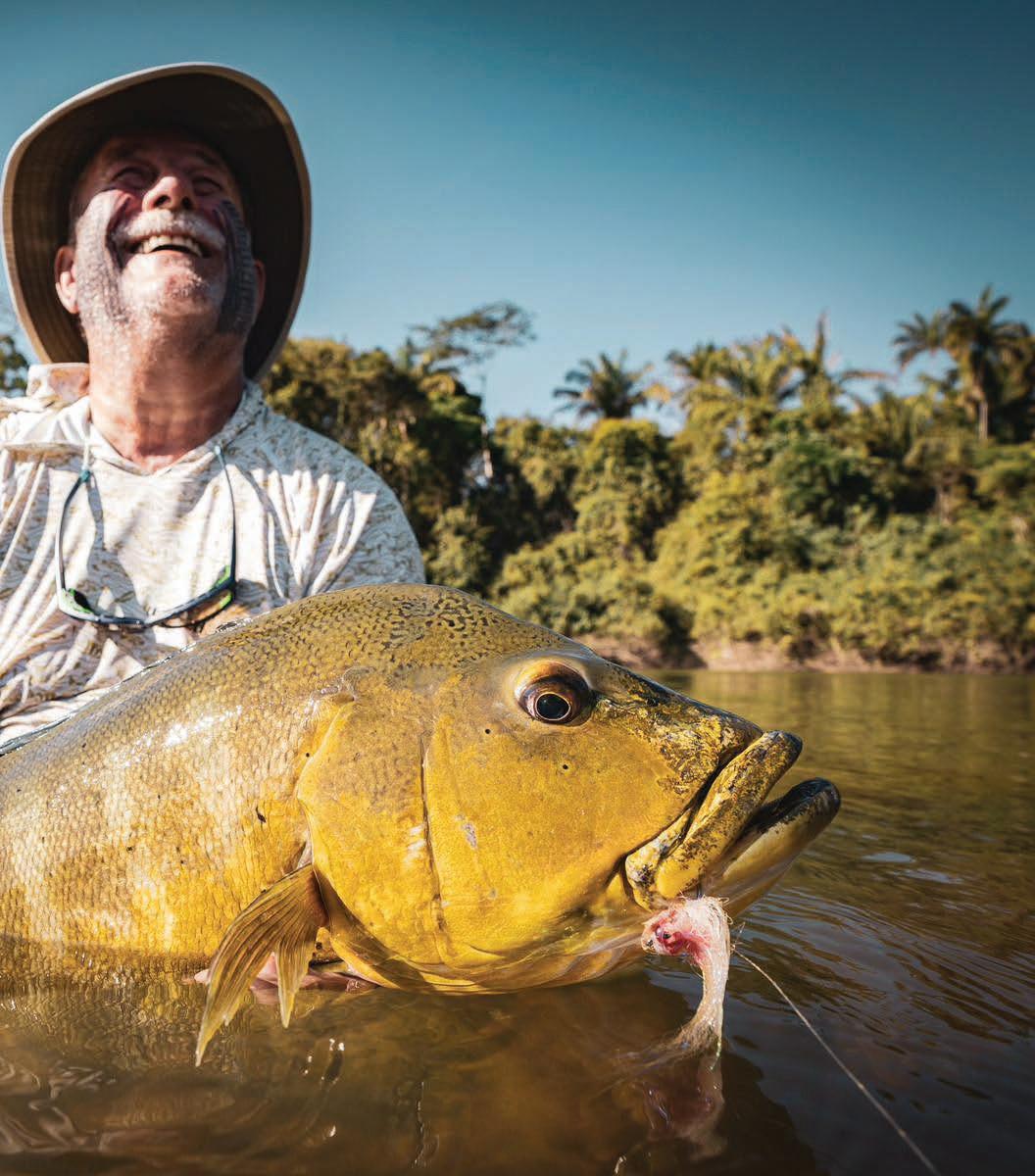









For peacock bass, we used streamers. The Iriri River is home to an endemic species of peacock bass found nowhere else in the world. Unlike other peacocks, these prefer moving water over stagnant pools. Sight fishing for them was an absolute rush, watching their aggressive strikes unfold before our eyes.
rows of sharp teeth, can reach up to 20 lbs in Kendjam. Seeing them ambush topwater flies was exhilarating. The matrinxã, pound-for-pound the strongest fighter in the jungle, was another highlight. These powerful fish eat fruit, flowers, insects, and other fish, making them a prime target for dry fly enthusiasts.
“This indigenous land is the Kayapó’s land—the land of warriors who have protected it for centuries. Here, in the heart of the reserve, they remain completely untouched. Fly fishing plays a role in preserving this area. The mission of the Kayapó and the anglers is the same—to keep the land intact. That is the legacy of this project.”
Another standout species was the wolf fish, which truly lives up to its name—attacking poppers and big flies with the ferocity of a pack of wolves chasing prey. These prehistoric-looking predators, armed with
Then there’s the bicuda—built like a barracuda, complete with a torpedo-shaped body and turbocharged tail. These fish are the true sprinters of the Iriri River and one of its most aggressive topwater predators.




Beyond the fishing itself, our guides made the experience even more special. Every guide team consisted of a professional guide and a native Kayapó guide—a perfect combination. The pro guide provided technical expertise, while the native guide’s deep knowledge of the jungle and river ensured an unforgettable adventure.
The Jungle
“At Kendjam, you’ll be fishing places that have been untouched for a very long time. I’ve been guiding here for about eight years, and I still find new places I’ve never fished before,” said our guide, Rafael Costa. And I truly believe him—the area is vast.
Kendjam is located in one of the most remote regions of the Brazilian Amazon—the Mekragnoti Indigenous Territory—550 miles southeast of Manaus. The Iriri River originates on the border of Mato Grosso and Pará, flowing northeast through the Amazon for over 800 miles before meeting the Xingu River. It is one of the most protected rivers in southern Brazil’s indigenous lands and ecological reserves.



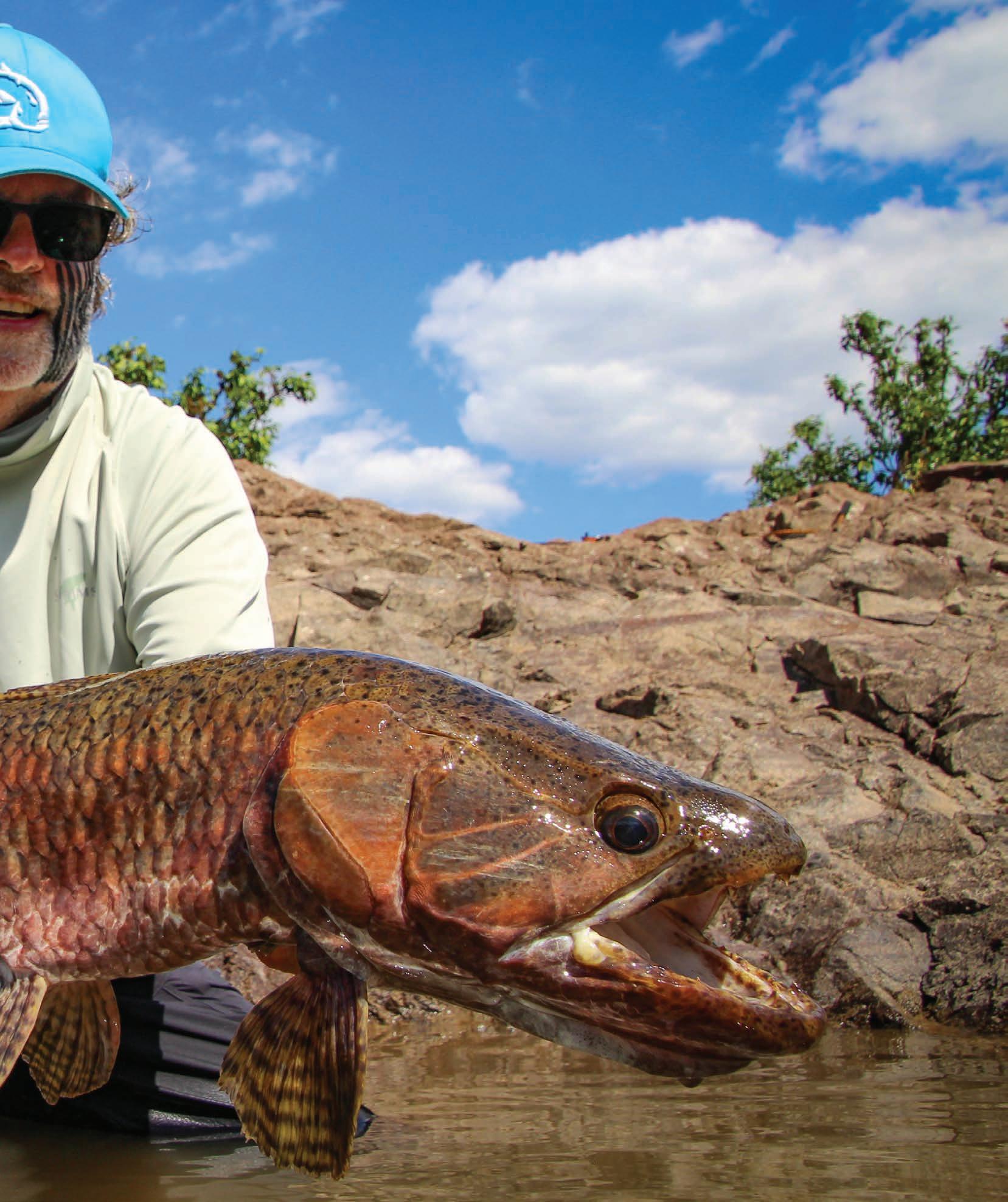

The landscape around the river is breathtaking, but it’s the flora and fauna that make it extraordinary. Towering trees, unique plant species, and an abundance of wildlife surround you at every turn. During our journey, we encountered jaguars, caimans, countless bird species, and even an anaconda. It was simply amazing.
The Untamed Angling concept is built on a partnership with Pykoré and Funai, the two indigenous associations representing the Kayapó people. Untamed Angling has established an honest and mutually beneficial relationship with the indigenous communities of the Amazon, ensuring that a portion of each angler’s fee goes directly to the local people. This project provides jobs, supports the Kayapó communities along the Iriri River, and helps them develop sustainable economic alternatives while protecting their land, culture, and way of life.
al painting ceremony, where Kayapó women adorned us with tribal markings. We learned that these paintings are an integral part of their culture - performed before hunting, fishing, celebrations, and even conflicts. On our last night, we gathered around a massive bonfire as the Kayapó performed traditional dances. We could feel their genuine interest in sharing their culture with us, just as we were eager to learn about their way of life in the jungle. We left with full hearts, deeply grateful for this rare and special experience.
From the very first day, we felt welcomed with open arms. We were honored to take part in a tradition-
Deep in the heart of the Brazilian Amazon, the Kayapó people, also known as the Mebêngôkre, have lived in harmony with the rainforest for centuries. Their vast territory, spanning approximately 11 million hectares, is one of the largest and most well-protected indigenous lands in Brazil. The Kayapó are not only known for their deep cultural traditions but also for their fierce commitment to protecting their environment against deforestation, illegal mining, and other external threats.
The Kayapó are a proud and independent people, organized into clans that emphasize communal living and strong leadership. Their villages are arranged in a circular layout, with a large central Men’s House serving as the hub for important gatherings and decision-making. Oral storytelling, song, and dance play a vital role in passing down knowledge, ensuring that younger generations remain connected to their ancestral heritage.
A striking aspect of Kayapó culture is their use of body painting and feathered ornaments, which hold deep symbolic meaning. Black and red body paint, often made from natural dyes, is used for ceremonies, hunting, and rites of passage, while intricate feathered headdresses signify social status and achievements.




Many Kayapó men also wear traditional lip disks and ear piercings, marking their journey into adulthood and their connection to their ancestors.
For the Kayapó, the Amazon is far more than a home—it is their library, their pharmacy, and their supermarket. Their deep ecological knowledge allows them to sustainably harvest the forest’s resources, utilizing medicinal plants, edible fruits, and hunting techniques that have been passed down for generations.
Hunting and fishing remain essential activities, with Kayapó men using bows, arrows, and poison-tipped darts to hunt game such as monkeys and birds. They also employ traditional fishing techniques, sometimes using crushed plantbased toxins to stun fish in the river. Women play a crucial role in gathering nuts, honey, and fruit, as well as cultivating staple crops such as manioc, corn, and bananas.
To bring our gear to life, we’re motivated by relentless curiosity and a passion for the wild. We evaluate hundreds of materials, build dozens of prototypes and spend seasons punishing them in the world’s most extreme conditions. The work is the guide, and we never tire of exploring, learning and improving. Obstacles do not block the path—they are the path.
68 PROTOTYPES
Relentless refinement of materials, fit and testing.
52 YEARS OF EXPERIENCE
A tradition of outdoor innovation and reliability.
31 FIELD TESTERS
Waders proven in the most extreme conditions.





By FELIX HANSVENCL

Greenland is a land of extremes— vast, untamed, and breathtakingly beautiful. Here, the rhythm of nature dictates the pace of life, offering an escape from the distractions of the modern world. For those seeking adventure, solitude, and world-class fishing, few places compare to the remote wilderness of Two River Valley.
When we first visited the location a few years ago, we quickly decided to take a closer look, as this was an opportunity we couldn’t let slip away. With a potential new lodge situated right by a beautiful river and a second river accessible via a short boat ride, the setup was already promising. Adding to this, the phenomenal ocean fishing in the area - a must-experience in Greenland - made the choice easy.
From big halibut and wolffish to cod and bright, chrome sea-run Arctic char feeding in the bays before their upriver journey, the ocean is a vast playground for anglers here. Unlike many locations where tides dictate your actions, this spot provides tide-independent access, allowing you to head out to the ocean or the other river whenever needed. Together with our partner, we developed a sustainable plan for the future and started this new project by building a lodge.
glers—is a true privilege. In today’s world, the demand for remoteness and disconnection is higher than ever, and for good reason. Anyone who has spent a week fishing in a remote Greenland location will likely tell you that returning to “civilization” can feel jarring. From navigating stressed airport crowds to getting nudged in line for a coffee, the transition back is not always easy. The immense value of an off-thegrid experience like this cannot be overstated, and Greenland provides the perfect setting for it.
Having access to such a pristine, remote fishing area—shared only with a small group of like-minded an-
When you arrive at Two River Valley Lodge, the importance of good logistics in Greenland becomes immediately apparent. With nature dictating life here, reliable infrastructure is essential for a smooth experience. A nice sandbar just below the lodge allows our boat to drop off clients, bags, and supplies throughout the week, ensuring an easy arrival process. From there, it is a short walk to the newly built lodge, perched on a hill overlooking the river mouth and ocean bay.


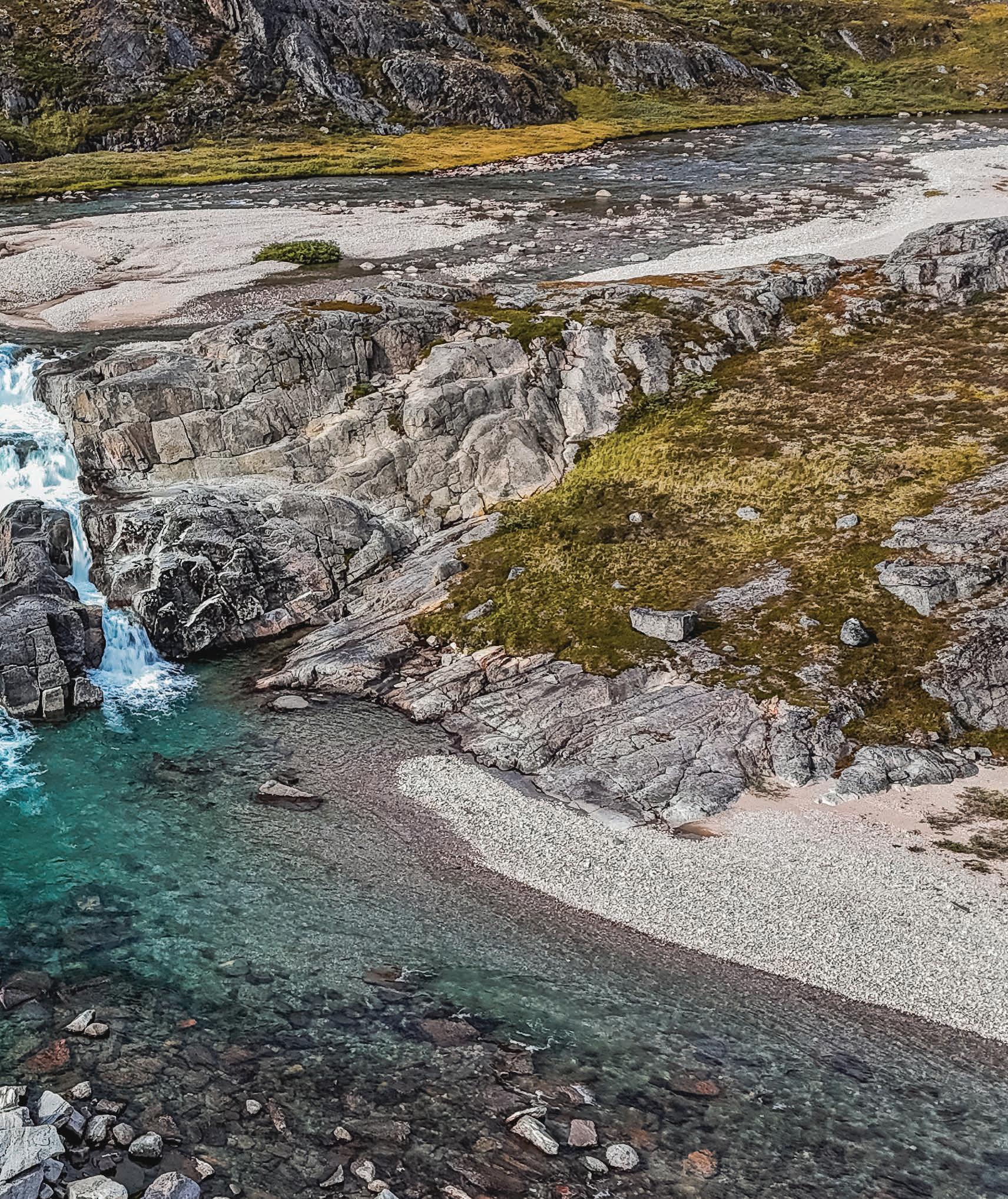








The lodge offers single and double rooms for well-earned rest between fishing sessions. If you’re lucky, you might even catch the Northern Lights from the bar or your bedroom window. The first fishing pool is just a two-minute walk from the lodge. From there, you can access the ocean shore to cast for halibut, Arctic char, cod, and wolffish.
If this sounds too easy, don’t be misled—this is still Greenland. It is wild and vast, leaving it up to you to decide how much you want to hike and explore. The options are endless. However, at Two River Valley, extensive hiking is not a requirement. If you prefer a more relaxed pace and want to stay close to the lodge or anchorage on our second river, there is plenty of water to fish nearby, and the option to explore the ocean by boat is always available.
The river next to the lodge is divided into two main sections. Near the lodge, the lower stretch features deep, crystal-clear pools and a lower lake section with the perfect current for stripping flies over rocks or skating a dry fly. Watching a bow wave form behind your fly is an experience that is hard to beat. These spots are just a 15-minute walk from the lodge, giving everyone the option and comfort of staying close.


On our first scouting trip in September, we landed a stunning 4 kg (8–9 lb) Arctic char within just a few casts. The fish put on a spectacular show, taking to the air multiple times before we could safely land it. We saw plenty of fish averaging 2-3 kg (4-6.5 lbs), and a few closer to 5-6 kg (11-13 lbs). The potential here is immense, and we’re excited to see what’s possible as our guests explore these waters.
Above the lower river, a lake section opens up, which you can quickly cross by boat to reach the upper river. Here, the river splits into several channels across a vast sandy bay. The mountains in the background and the sight of schools of fish holding near the currents make this spot very special. During our scouting trip, this location became a natural coffee stop, allowing us to take in the magnificent surroundings.



Following the river upstream leads to a waterfall that stops the fish migration, with larger, salmon- and steelhead-like pools along the way.
“The ocean-fresh char seem to fight even harder than their river counterparts”
With access to nearby elevations, there are plenty of spots where you can easily observe schools of fish from above and watch their movements. We had a lot of fun guiding each other onto fish by shouting instructions on where to cast, when to strip, and when to strike.
It was proper teamwork and so much fun! Some pools feature huge rocks in the water, creating a setting that felt like an arena with cliff walls on each side. The hike from the lodge up to the waterfall and back makes for a great day trip for those who want to explore further.
On another day of our scouting trip, we ventured to the second river. After packing our gear and hopping into one of the lodge’s Targa-style boats, we set off. The journey itself was an adventure, featuring rugged rock formations, towering mountains, and humpback whales feeding on the abundant krill and fish.
Two of the humpbacks seemed to frequent the area, and we saw them nearly every time we were at sea. Often, they came as close as five meters from the boat, leaving us in awe. Watching them glide gracefully through the water is something you need to see in real life—it is a thousand times better than any Instagram video.
Once you enter the fjord, you can see how everything narrows until you reach the bay that grants access to the river. After anchoring the boat, we followed reindeer trails upstream to explore the river’s structure. Everything is so vast in Greenland, and this river valley often made us feel like we were part of a scene from The Lord of the Rings.


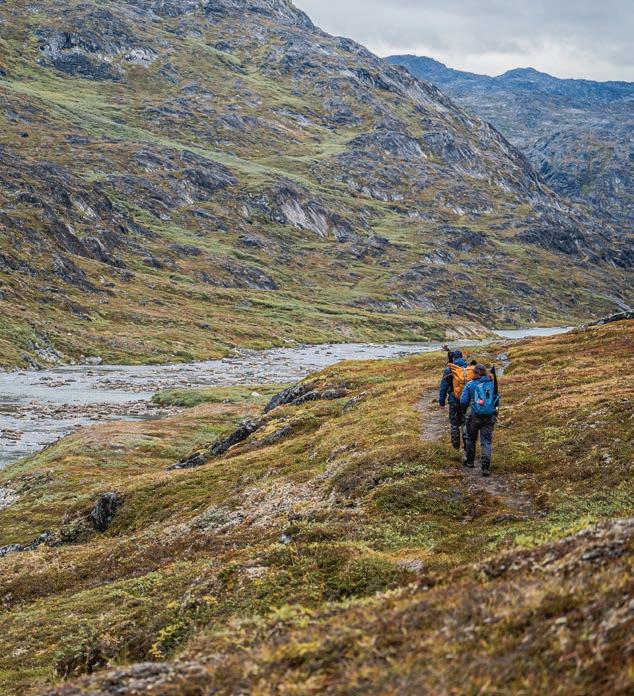



The river itself is comparable in size to a small salmon river, flowing next to a massive cliff wall, making you feel quite small in its presence. What we found particularly fascinating was the variety of fishing opportunities: stalking individual fish in small pools and channels or targeting schools in larger holding pools. One moment, we were crawling on our knees to approach two fish near a rock, and the next, we were casting into a wide pool filled with freshly arrived fish. The variety kept the day exciting and left us eager to explore more. We spent the whole day here, hiking extensively, yet we only saw a fraction of what this valley has to offer. For those looking for a serious hike, this is your place.
On our way back, we couldn’t resist stopping at some ocean fishing spots. While we didn’t land any halibut that day, we caught a few cod for dinner and spent more time watching whales. Fishing the ocean with a fly rod is a unique experience.






When targeting sea-run Arctic char, speed is key - strip your fly fast, or risk having it grabbed by one of the countless cod! These ocean-fresh char seem to fight even harder than their river counterparts, which is hard to imagine after battling them in the river. They just never give up! July is an excellent month for targeting char in the ocean, and we discovered new spots daily.
Back at the lodge, we enjoyed a delicious dinner of fresh cod and gathered around the fireplace. With no
screens to distract us, the conversations were better, and falling asleep was effortless. I stayed up late, hoping to see the Northern Lights. At around 12:30 a.m., they suddenly appeared. I stumbled into the other rooms, waking Glenda and Lawson to join me.
With sleepy eyes and wild hair, we took way too many photos. I even managed to fall into a hole while walking backward for the perfect angle. A good laugh and some decent photos later, I made my way to bed and slept like a baby.


These days rounded off a complete Greenland experience, and we can’t wait to share it from 2025 onward. Fishing trips are never just about fishing, and when it comes to Greenland and Two River Valley, we can confidently say this is one of the best all-around adventures to share with a friend, partner, family member, or fishing buddy.
For tackle, we recommend a 6 or 7-weight single-handed rod, such as the Solid S1 696-5 and 796-5 models we used. These rods provide the extra length needed for rivers of this size while offering enough power to handle larger fish in the ocean. Designed in five pieces, they pack easily into your bags without requiring an additional checked rod tube during travel.




A trout spey rod paired with a short Skagit shooting head is another exciting option, as swinging flies for Arctic char is exceptionally effective. Floating lines work well in the rivers, while a sink-tip line is useful for ocean fishing.
If you’re targeting halibut, a heavy rod with a sinking line is essential.
Traveling to Greenland is set to become much easier this year. The opening of the new international airport in Nuuk has introduced more direct flights from Europe and the USA. Upon arrival in Nuuk, a boat will pick you up and take you directly to Two River Valley Lodge, making this adventure more accessible than ever.
For more information about planning a trip to Two River Valley: felix@solidadventures.com www.solidadventures.com



www.instagram.com/falknertours/





Falkner Tours is a travel agency specializing in fly fishing, hunting and skiing tours in Argentine Patagonia.
We are in the Lake District, in the north of Patagonia. We have hotels, lodges, guides and transfers in this area as well as transfers in Buenos Aires between the international and domestic airports.
We organize weeks of fly fishing from November to April. And among the trout you can catch are brown, rainbow and brook trout...
Come fish in Patagonia with a serious company, where the



Our convoy of three Toyota Landcruisers is on a dirt road heading deep into the African jungle towards a remote area of the Zambezi River. The radio signal is getting weaker and weaker. The local Zambian radio station is talking about the iconic fight between George Foreman and Muhammed Ali that took place on this exact date 50 years ago, known as the “Rumble in the jungle

By GORDON P. HENRIKSEN
Images by COLUMBUS LETH

The radio conversation sets the mood for the experience awaiting us. But here, instead of a heavyweight fight, ours will be a battle of wills between us fly fishermen and one of Africa’s most aggressive and powerful predators: the tigerfish. With a swift strike, blistering speed, and raw strength, the tigerfish is the undisputed champion of these waters – a true fighter whose reputation for ferocity is as legendary as the battle that took place 50 years ago. And it is a fish I have dreamed of battling for years! The tigerfish are certainly waiting to challenge us to fight at our best, but more importantly, the continent of Africa, the Zambezi River, and all its inhabitants – both human and wild – are about to teach us what fly fishing adventures are really all about.
We unload our gear on the riverbank, keeping a safe distance from the crocodile-rich waters. We are, of course, bringing our fly-fishing gear, but more importantly, plenty of food and ice to keep us going for eight days, along with plenty of beer and brandy too! We take a boat upriver and begin to
realize what an amazing adventure we are embarking on. Rugged mountains open up on each side of the river, and as we arrive at the “Kingfisher Lodge” – a camp just on the edge of the part of the river known as “The Gorge” –we see cliffed walls on each side, swift currents, small rapids, and experience an unmistakable sense of wilderness in the truest sense of the word.
As we arrive at the camp, a group of five elephants are on the shoreline, and I am blown away by the majesty of seeing these huge, impressive beings in their own environment. Our guide and host, Thor, calmly but firmly tells us that these creatures are not to be taken lightly. They may seem calm, docile, and friendly, and they are most of the time. But if cornered, spooked, or provoked, they can attack and run you down. Needless to say, no one walks away from being trampled by an elephant. With elephants in sight, I am overwhelmed - not only by the untouched beauty of this wilderness but also by its dangers. And now, it’s time to unpack our bags and head out fishing before the sun goes down.




The Zambezi River offers an incredible environment for anglers with its mix of slow-moving pools and fast-moving rapids. We fish from small boats with casting platforms in the front. The fishing involves drifting and casting from one fishy-looking spot after another. Tigerfish can often be found in the eddies and pools formed around rocks, submerged structures, and at the mouths of tributaries, where they lie in ambush, waiting to strike at unsuspecting prey.
We fish deep pools and fast, shallow water that almost remind me of some of the swinging-style fishing I’ve done for salmon. One major difference here, however, is the crocodiles. We see them on the shore, and we spot their eyes popping up here and there in the river, giving the constant impression that they are lurking and ready to attack.
Thor and the locals are all very clear in their safety briefing: NEVER put your hands in the water. Not even to rinse off some sunblock, and cer-
tainly not to release a fish. And let’s not even get into how scary falling in the water would be. Every cast I make, I am more focused on keeping my balance than I am on throwing tight loops. I do not plan on falling into that water!
And then, of course, there’s the wade fishing that we do a little of, but always standing at least three meters from the shore or up on a rock or cliff. There’s always the underlying awareness that, at any moment, a crocodile could appear from the depths and make a move toward you. Their explosive power and speed when attacking are ever-present and keep your nervous system engaged and alert, no matter how much you want to focus on the task at hand.
Oh, and there are hippos everywhere, too. They are regarded as one of Africa’s most dangerous animals. Though they appear docile and slow on land, hippos are incredibly territorial and can move surprisingly fast in the water, often charging boats with little warning.






While you might be focused on your fly or watching the surface for the telltale signs of a fish strike, a nearby pod of hippos could decide to enter your territory. But back to the fish, and the focus of our trip.
The tigerfish (Hydrocynus vittatus) is a striking predator, renowned for its sharp, canine-like teeth and ferocious nature. Its body, sleek and muscular, is built for speed, enabling it to chase down prey with incredible agility.
The species thrives in the fast-moving waters of the Zambezi, where it feeds on smaller fish. Tigerfish belong to the family Alestidae, found across much of Africa. They grow to formidable sizes, with some specimens exceeding 30 pounds (14 kg). The average trophy fish is around 10-15 pounds (4.5-6.8 kg). They are characterized by their elongated bodies, silvery-greenish coloration, and the iconic pattern of dark vertical stripes that gives them their “tiger” name.
As ambush predators, tigerfish are known for their explosive strikes, violent high-speed runs, and for jumping like madmen. Their razor-sharp teeth are specially adapted to grasping and tearing into prey. It’s this predatory aggression, combined with their ferocious look, that makes them such a special fish to chase with a fly.
Catching tigerfish is no easy task. We’re talking about lots of casts with big flies, wire leaders, and sinking or sink-tip lines, with bites being few and far between. But when they do come – Wow, it’s magical! The strike is hard, the fish is jumpy, and fear of losing the hook set in the mouth is present throughout the entire fight. When your fish finally comes up for a quick photo, it’s hard not to be in awe of such a cool creature, with a particularly prehistoric look and feel that reminds you it has evolved over millions of years to become what it is today, shaped by this environment with constant dangers from crocs, fish eagles, and more.

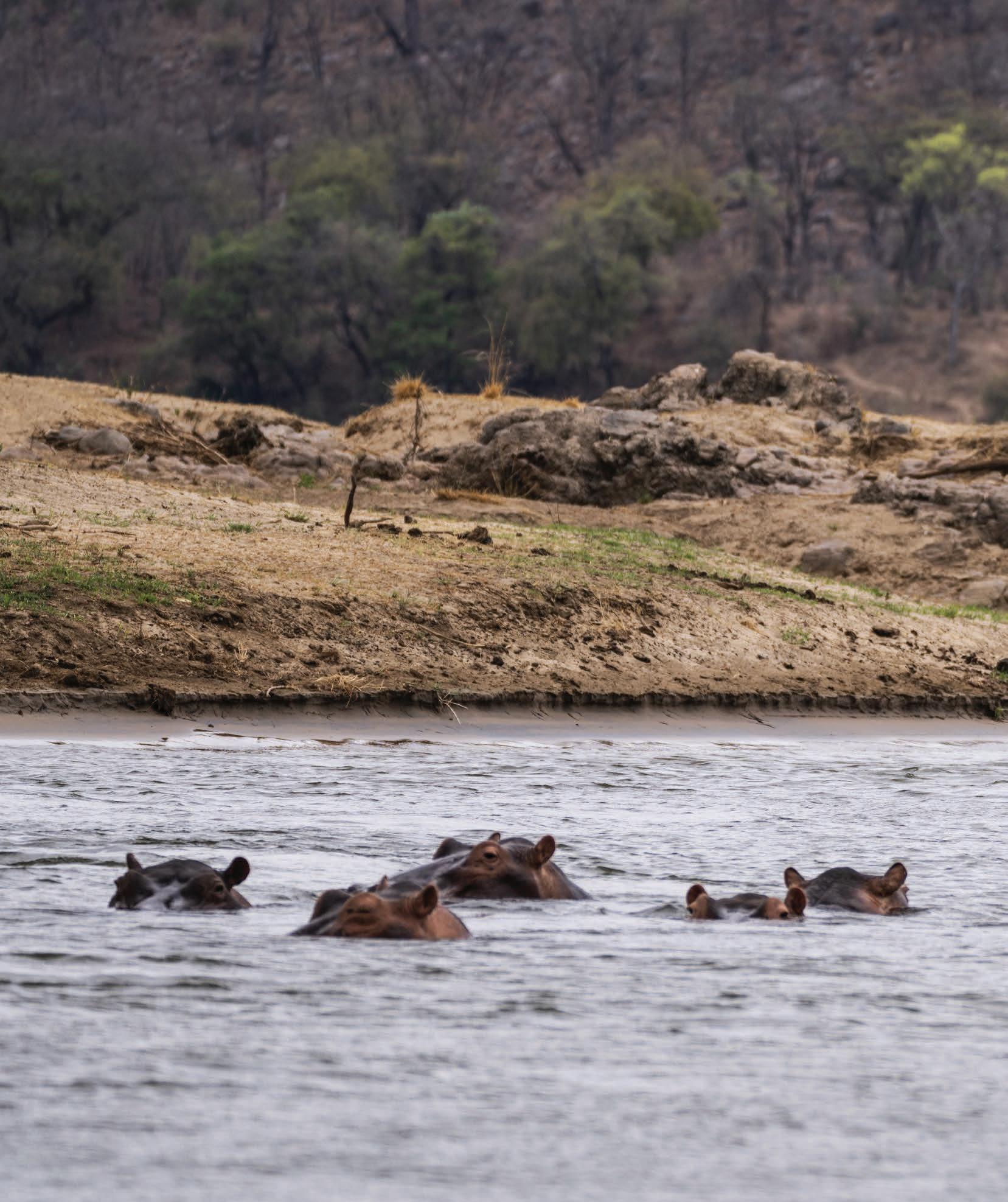




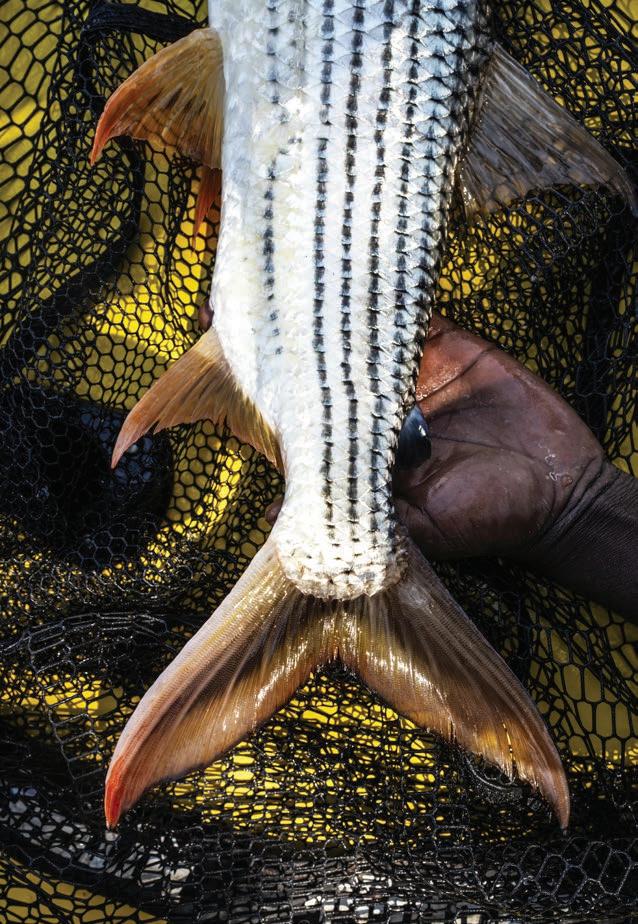



I know I keep talking about all the dangers, but in many ways, they defined my sense of well-being throughout this entire trip. Hippos and crocs in the river, lions, hyenas, and elephants on the shore are ever-present, not to mention the smaller, more subtle dangers like scorpions and snakes…
For many, fly fishing is synonymous with peace – an opportunity to disconnect from the noise of daily life, find solace in the rhythm of the water, and allow the tension of the world to slip away with each cast. The idea of a tranquil day on the river, the gentle lapping of water against the boat, the rhythmic motion of the fly line cutting through the air – this is the calming image most anglers associate with fly fishing. It is, after all, often called a “meditative” pursuit, a way to find balance, peace, and stillness in nature.
Not so here. The peace you seek is constantly interrupted by the very real, ever-present dangers of the African wilderness. The tension between seeking
tranquility and being confronted by the raw power of nature is what makes fishing on the Zambezi so unforgettable. The river, with its beauty and its dangers, keeps you in a state of heightened awareness – a constant balancing act between the desire to relax and the need to remain alert. It is this tension, this challenge, that makes the Zambezi River not just a fishing destination, but a place where you come face-toface with the wild in its most untamed and untouched form.
“The tension between seeking tranquility and being confronted by the raw power of nature is what makes fishing on the Zambezi so unforgettable”
So many emotions come together to make this trip an incredible experience of a lifetime. Let me give you an example. One day, we decide to harvest a tigerfish for a “shore lunch.”


Catch-and-release is the norm, but it is not frowned upon to take one fish for cooking. If you’re like me, tasting the prize of all your efforts is an essential part of it – especially when you can cook the fish over a fire right there on the bank, surrounded by hippos and crocs! Here, everything comes together.
If you’ll let me exaggerate a little, the process of catching, killing, cooking, and eating a tigerfish right there on the bank is a ceremony of becoming one with nature – consuming it directly while being completely immersed in true wilderness and nature in its wildest form. But it’s also about the people we are sharing the meal with and now becoming united with in a very special way that is so much stronger than just going out for a beer or coffee with a friend back home. Somehow, I am reminded that when planning for a trip like this, my focus is on the fish itself, on what flies and gear to bring. But when I stand here on the bank with beer breath and tigerfish bones between my teeth, I realize that this adventure is not just about
landing a fish – it’s about immersing yourself in an experience that touches all your senses, every part of your being. It’s about the food, the people, the culture, and the landscapes that make the journey so unforgettable. In many ways, fishing is a direct link to the environment – your success depends on understanding the rhythms of nature, the patterns of the river, and the life within and around it. Had I not been a fly fisherman, I would never have considered this trip, never would have made the effort, or spent the time and money to get here. But standing here now, I feel immensely grateful for this experience and for the fact that I am a fly fisherman.
The best time to fly fish the Zambezi River is typically during the dry season (May to October), when the water is lower and clearer, and the tigerfish are most active. If it rains heavily upstream, the river turns dark and murky, making it almost impossible for the tigerfish to spot the fly. We fished at the Kingfisher Lodge and were hosted by Thor Kirschner.








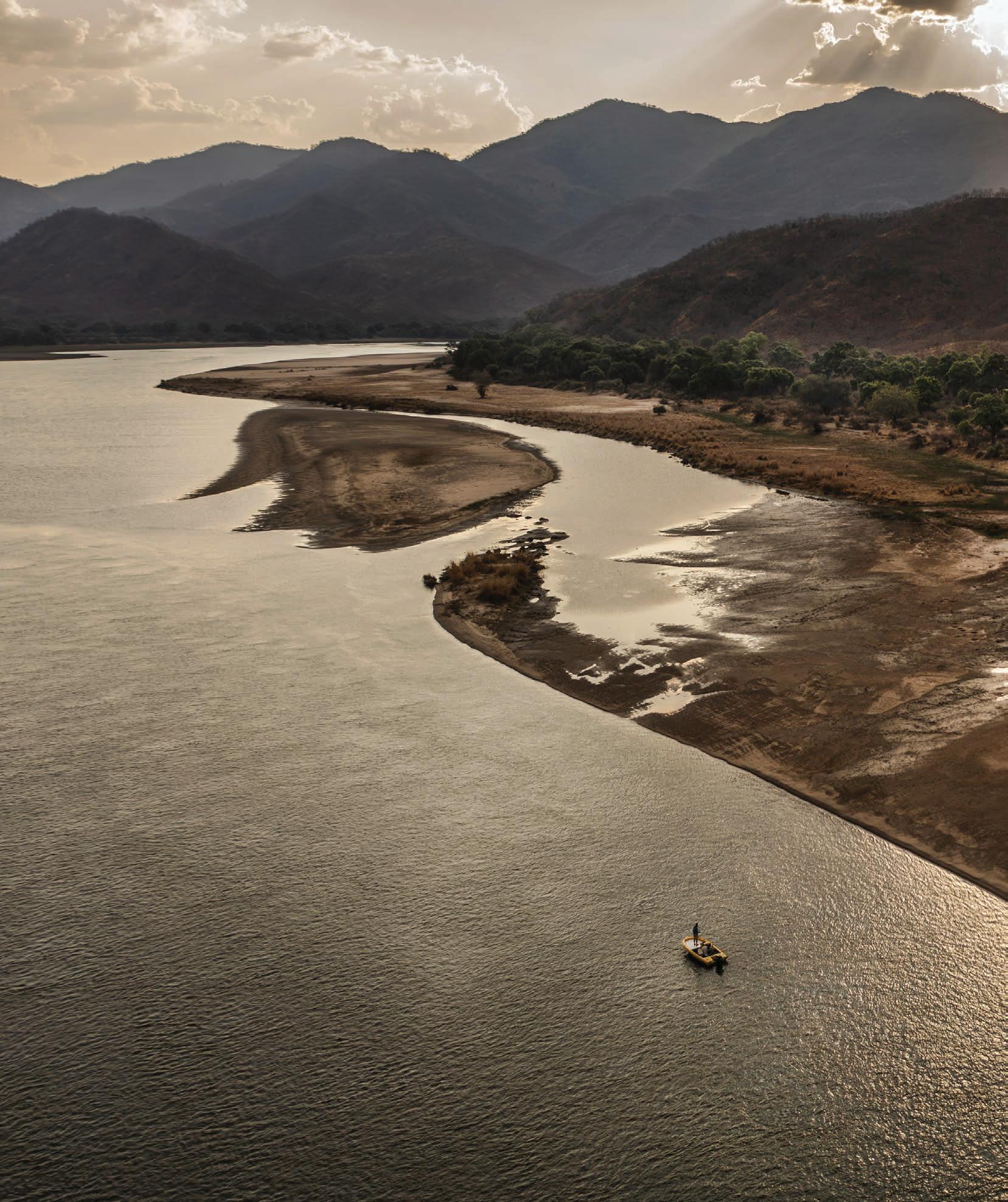


Thor is an extremely well-respected professional hunter who takes great pride in giving his clients the best possible experience when it comes to hunting, fishing, and the overall adventure. Thor has my highest recommendation. Check out the possibilities at www.mingaadventures.com.
Large streamers are your best bet for tigerfish, as they mimic the typical preyfish that tigerfish target. Streamers and baitfish imitations, such as Clouser Minnows, Deceivers, and the like, are good choices. Bright colors like chartreuse, orange, and yellow often work well, as tigerfish are known for their aggressive nature and are attracted to high-visibility flies. However, natural colors and brown/white patterns also seem popular when the water is clear.
The river’s currents are swift, and you are fishing from a drifting boat, so a fly with enough weight to cut through the water and sink quickly to the fish’s strike zone is essential. Aim for flies that are 4-6 inches (10-15 cm) in length. To be honest, I don’t have enough personal experience from
this one trip to give you really solid advice on the flies, so trust your instincts and find some fishy streamer patterns you believe in.
Going big and heavy on flies, of course, makes casting more of a challenge, but that’s where picking the right line becomes important.
Line: A sinking or sink-tip line is preferable to get the fly down quickly in the heavy current. Make sure it’s one that is comfortable to cast and can be cast fairly precisely towards rocks, shorelines, and other fishy-looking places. I used a Sonar Titan from Scientific Angler that worked well for the job.
Rod: An 8- or 9-weight fly rod is ideal for tigerfish, as it gives you the power to cast larger, heavier flies and lines, and also fight the strong fish in the currents.
Leader and Tippet: Due to the tigerfish’s sharp, serrated teeth, a strong and abrasion-resistant wire leader is a must. Basically, anything that works for fly fishing for other toothy critters like barracuda or pike should do the trick.











When you buy the new measuring tape from Redd Villaksen, all distributor proceeds go directly towards NASF Norways unwavering work to protect and conserve the wild Atlantic salmon stocks. For more info, please refer to: https://reddvillaksen.no








Grundéns:
2.15.25)
Building on a legacy of ruggedness and durability, Grunden’s award-winning Vector Zip Stockingfoot Wader provides best-in-class abrasion and puncture resistance while enhancing the in-water fishing experience with a fully-submersible zipper entry and patent pending fishing features including a 360° pocketing and storage system. The ultra-dense microfiber 4-layer waterproof breathable shell allows fishermen that typically beat up on their waders to explore farther while maintaining a 30K+ waterproof rating for dryness, comfort, and ultimate protection. The patent pending HAULER™ POCKET offers a rear pocketing system that eliminates unnecessary bulk in the front of waders when casting and a welded tippet pocket allows for quick and easy rigging at a moment’s notice. Add in the TI-Zip MasterSeal 10 Zipper for a 100% waterproof, ease-of-entry, 4mm molded-in Ortholite knee pads, and size-specific stockingfeet with TiAlpha warming neoprene and Grundéns has built a bulletproof wader that simply boasts their proven philosophy of providing durable, guaranteed products. For more info, please visit www.grundens.com


Destined for elevated backcountry expeditions, the new Headwaters Backpack divides, conquers, and corrals with a rugged 630-Denier build, magnetic rolltop closure, ample storage options for fishing necessities, and an ergonomic fit that comfortably handles your long hauls and heavy payloads. The backpack features: Durable and water resistant 630 Denier High-Density Oxford Nylon fabric with TPU coated frontside and PU coated backside, Coated water-resistant YKK Aquaguard zippers, Unique integration of a fully waterproof, roll-top liner into the main compartment with magnetic closure, Main compartment liner is secured to the bottom with hook and loop and can be turned inside out to clean or dry, Top drop-in and front access pockets, and much more. For more information, please refer to the European distributor, Flyfish Europe – www.flyfisheurope.com/simms



Renomed: FLY TYING
Renomed makes surgical scissors of the highest quality – in addition to making the finest fly tying scissors out there. They’ve recently expanded their fly tying scissor range, and we’ve had the chance to test SuperCut Fly Tyer Scissor. These medium-sized scissors combine two unique features: SuperCut blades and enlarged loops. The enlarged loops offer more comfort and precision handling, and the SuperCut blades feature a unique serrated blade combined with a razor type blade, which equals extraordinary performance and durability. For precision work on dry flies and streamers, these are the best fly tying scissors we’ve had in our hands. Highly recommended! (NB! Gift boxes are sold separately). For more info, please refer to www.renomed.eu
Women’s Outerwear : SIMMS G3 GUIDE JACKET
The W’s G3 Guide™ Jacket redefines fit, function, and performance with its advanced 3-layer GORE-TEX construction, offering superior mobility and all-weather protection. Designed for anglers, it features strategically mapped fabrics for ease of rowing and casting, a 3-point adjustable storm hood, and two spacious, fly-box-compatible chest pockets. A hidden fly patch on the left chest pocket flips down for convenience, while dual zippered handwarmer pockets sit high to prevent water entry during deep wading. The low-profile cuff and hem are easily adjustable for a secure fit. Learn more at www.flyfisheurope.com/simms



Smith Creek’s FlyVue™ is a premium-quality chest pack system that is loaded with smart features. If you have ever struggled to tie fine gauge tippet line while out on the water, FlyVue can help (even if your eyes are fine and you don’t wear glasses). FlyVue’s integrated 3X Fresnel magnifier gives you a generous field of view to tie even the smallest of tippet lines without fumbling, saving you time and trouble. Flush mounted torque hinges hold the magnifying lens and fly trays at a fixed angle until you are ready to close it. Specialized inner tray hinges allow you to insert fly trays in 4 different positions, while an additional mini-patch on the lid holds up to 9 additional flies for ready use. FlyVue’s rear plate has rib slots along the side, allowing you to attach small accessories if you wish, while the small bottom clip attaches to your vest or jacket to prevent your FlyVue™ from swinging away from your body when leaning over. With 5 different tray styles to choose from, FlyVue™ can literally hold hundreds of flies, storing what you need for a day out on the water without weighing you down. For more info: www.flyfisheurope.com/smithcreek
The LineMaster line tray from Danish company, Easy Shrimp Eyes, is designed to reduce tangles, letting you focus on what really matters - fishing. With 26 XL curved spikes, the LineMaster offers superior line separation like never before. Each spike is approximately 10 cm long, keeping your fly line secure even in windy conditions. The flexible curved spike design ensures smooth line release when you need it. Built for performance, the tray features a spacious base measuring 28.5 cm wide and between 9.5 to 23.5 cm deep, providing plenty of room for effortless line management. We’ve had the pleasure of testing these new line trays, and they’re extremely well-made, functional, easy-to-use, and –not least – sturdy. A highly recommended product for those who fly fish for seatrout along the coastal shores or target gamefish on the flats. For more info about the product, please visit: www.easyshrimpeyes.dk



Insta360:
The Insta360 Flow Pro 2 gimbal stabilizer is a gamechanger for capturing buttery-smooth fly fishing foo tage. Whether you’re filming casting techniques, the thrill of a strike, or a scenic river landscape, this AIpowered stabilizer keeps shots fluid and shake-free.
One of its standout features is 360-degree tracking, which is perfect for following the motion of a fly cast or a fish being fought. The upgraded AI tracking en sures the subject stays in the frame, even if you’re moving along the riverbank or wading th rough the water. The built-in gimbal stabilization eliminates jitters from handheld shooting, making it ideal for action-packed fishing sequences.


Another major advantage is its compact and foldable design, making it easy to carry in a fishing vest or pack. The Flow Pro 2 also has a built-in power bank, so you won’t run out of juice while filming long days on the water. Its intuitive controls allow for one-handed operation, letting you focus on fishing while effortlessly capturing the moment.
For fly anglers who love documenting their adventures, the Insta360 Flow Pro 2 ensures that every cast, strike, and release is recorded with professional-grade smoothness, making your fishing videos truly immersive: www.insta360.com/sal/flow-2-pro?utm_term=INRIITB

The Patagonia Men’s Swiftcurrent Wading Jacket is a top choice for anglers, offering excellent weather protection with its 3-layer H2No® waterproof and breathable fabric. The adjustable 3-point storm hood and waterproof zippers keep you dry in harsh conditions. Its articulated sleeves and gusseted underarms provide full mobility for casting, while large front pockets and a zippered chest pocket offer ample storage for gear. The low-profile cuffs and hem adjustment ensure a snug, water-resistant fit. Durable, functional, and comfortable, the Swiftcurrent Wading Jacket is perfect for anglers in tough conditions. More at www.patagonia.com

Measuring Tape: HELP THE NORWEGIAN NASF CHAPTER SAVE THE ATLANTIC SALMON
Redd Villaksen, the Norwegian NASF chapter, works tirelessly to protect wild Atlantic salmon and other vulnerable salmonids. Purchasing this measuring tape directly supports their mission to preserve one of nature’s most remarkable species—all FFE profits go to Redd Villaksen!
This 150cm, spring-loaded measuring tape is compact, durable, and easy to use with a push-button retrieval system. It includes a fish ID guide, weight estimates based on the fish’s condition (slender, normal, compact), and an integrated clip-on wristband. Designed for Villaksen by Smith Creek, New Zealand.

These awesome tails are made from a synthetic suede material and can be used to imitate a lot of different baitfish in different sizes. If you think our sizes are too large or too small, simply cut and tie it on as you like. You will get 6 per pack in each size. Also, these tails go great with the Rattle Diver Kit. See photos for length/width. (Note: always use fabric makers or dye to make your flies last longer.) For more info, please refer to: www.flyskinz.com
Primal’s new Compressed Carbon Chain (CCC) technology utilises an incredibly low mass oblique exterior carbon wrap that constricts at a high rate during the curing process to compress the rod’s longitudinal fibres to create a denser, stronger blank with higher sensitivity, quicker recovery and ultra-light swing weight. CCC rods combine with Ultra-Light Helical Core, to create intelligent rods that support hoop strength and stabilise the blank in flex. The graphene nano in Primal rods is there for a purpose, not just for pixie dust. Nano works best with compression fibres, so we use it to improve axial resilience and not just so we can add in an extra buzzword. The end result is that the Primal RAW is a freshwater fly rod that outperforms other overpriced rods at a price that means the only bank you will hit is the far one. For more info, please refer to the European distributor, www.flyfisheurope.com/primal
Catching a beautiful salmon on a fly and writing wonderful literature about the subject of doing so both require a right time and place. For Julian Pullan, the right time and place to write his new book about the pursuit and protection of Atlantic salmon was the pandemic and his home office. Reading it, it’s evident that Julian has put his heart and soul into writing a comprehensive book that is both informative and engaging. Whether you’re a hardcore salmon angler, one of the newly-initiated, or someone simply fascinated by the Atlantic salmon this book is a treasure trove of information, insights, amusing (and sometimes saddening) anecdotes, and lots of great tales that will have you smirk surprisedly, make you reach for that double-handed fly rod of yours, or compel you to sit down and tie a Green Highlander or a big Sunray Shadow. Right Place Right Time is a must-read!

Squimpish Hair is perfect for big sandeel patterns, GT flies, and large pike streamers, combining the natural look of bucktail with the durability and consistency of synthetic fibers. Whether you’re a professional fly tyer or just starting out, Squimpish Hair delivers exceptional performance and versatility, making it an ideal choice for any fly pattern.

Each patch contains fibers ranging from 3” to 12” in length, allowing for a wide range of fly designs. The fibers feature a natural taper, maintaining the same diameter from base to tip while varying in length for a more realistic look and feel. They can be cut to any length and reshuffled to restore their natural shape and taper, offering endless customization options. Additionally, Squimpish Hair retains little to no water, making each cast effortless as it sheds water with ease. For more information, please visit: www.squimpishflies.com
Designed by Flyfish Europe for double-handed fly casting, the Headway Strategic tapers offer a more compact version of the popular Headway bellies. Retaining the same powerful rear-weighted taper, they effortlessly load the rod, making spey casting easier and more efficient.
These bellies are designed to be used with a tip for optimal performance and come in five variants: Float, Float/Sink 2, Intermediate, Intermediate/Sink 3, and Sink 3/Sink 5. The rear-weighted distribution enhances rod loading and provides excellent angled casting capabilities. An orange tracer at the rear end ensures visual control while casting and fishing.

With no hinging between the belly and tip, these lines allow for smooth loops, improved presentation, and straightened tippets. The textured coating makes lifting the line from the water easier, and Scientific Anglers’ line-ID markings on both bellies and tips ensure quick and easy identification.
For more details, visit www.flyfisheurope.com/SA

elencuentroflyfishing.com • info@elencuentroflyfishing.com With three destinations offering access to a tremendous range of fisheries, and flexible, multi-day guided fishing and outdoor activity packages, El Encuentro can create the ideal trip for you.


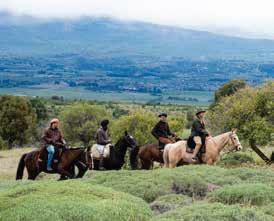








The morning sun cast a golden glow over Mount Everest’s snowcapped peak, marking the end of three days of continuous travel. As we descended toward Paro Airport, the realization set in—we had finally arrived in the mesmerizing Kingdom of Bhutan, also known as Druk Yul, meaning “Land of the Thunder Dragon

By KEITH ROSE-INNES


Ilya Sherbovich and I had been invited by our friends and avid fly fishermen, Ugyen Rinzin and Kencho Tshering. Years earlier, Ilya had fished alongside them for golden mahseer, and now he was returning—this time with me tagging along. Fishing for these prized fish in Bhutan requires special permission from the Royal Family’s office, as they are strictly protected. Ugyen had secured authorization for monitoring purposes, but only under a catch-and-release, fly-fishing-only basis.
The true significance of this trip would unfold as the days went by, but in the meantime, I was in awe of Bhutan—where prayer wheels spin in the wind, Buddhist flags drape the mountain ridges, and fierce dragon motifs adorn temple walls to ward off evil.
A Kingdom Steeped in Tradition Nestled in the Eastern Himalayas along the ancient Silk Road, Bhutan is one of the few nations never to have been colonized. For centuries, Druk Yul remained secluded,
preserving its deep-rooted Buddhist traditions and cultural identity. Its people, the Drukpa (Dragon People), are ruled by the Druk Gyalpo (Thunder Dragon Kings).
A testament to Bhutan’s unique approach to governance is the philosophy of Gross National Happiness, a concept introduced in 1972 by King Jigme Singye Wangchuck, who declared, “Gross National Happiness is more important than Gross Domestic Product.” This focus on well-being over wealth has shaped the nation’s development, ensuring the preservation of its heritage and values.
Given Bhutan’s rugged terrain, a helicopter was essential for covering the vast distances required to fish the three planned rivers. After clearing customs, we boarded the chopper for a one-hour flight from Paro, descending from the crisp, cool air of the mountains into the humid, subtropical jungle. Our basecamp, set up along one of the main rivers, would be our launching point for the adventure ahead.
Despite our excitement, we knew very little about the river conditions, and local knowledge would be our key to success. The golden mahseer are notoriously elusive, known for their sharp senses and their reluctance to take a fly. Over the next ten days, Ugyen and Kencho would guide us on a journey that was as much about Bhutanese culture as it was about fishing. We would sip leaf cups of rice wine and bamboo mugs of potato beer, prepared by the locals, fully immersing ourselves in the country’s way of life.
The Challenge of the Golden Mahseer Golden mahseer possess an extraordinary sense of smell and are incredibly sensitive to vibrations—traits that make them as frustrating to fish as permit. One advantage we had was their relatively poor eyesight, likely due to the mixture of murky and clear waters in the rivers. Still, their heightened senses meant that any misstep could spook an entire school.
On our first morning, we made our way to a clear creek above basecamp, where chocolate and golden mahseer were lined up in the current. As we approached, Ugyen cautioned, “Keep quiet, move slowly, and avoid touching the water—the fish will spook.”









My heart raced at the sight of so many large fish, and I naively assumed that landing one would be easy. Sensing my overconfidence, Ugyen laughed.
“It was a humbling lesson in just how challenging this species could be”
To demonstrate the mahseer’s sensitivity, Kencho asked one of our expedition members standing 20 meters upstream to submerge his hands in the water. As the scent drifted downstream and reached the main river, every single fish vanished in an instant, not returning until the following morning. It was a humbling lesson in just how challenging this species could be.
Understanding that even the slightest disturbance could ruin our chances, we adapted our approach. The helicopter would avoid flying over clear creeks and would land far downstream to prevent vibrations in the
water. Once on the riverbank, we meticulously planned our casts— washing our hands, wetting our lines and flies, and walking carefully to the casting area. Every move was calculated, every cast deliberate. Often, the problem wasn’t a lack of fish but rather an abundance of them. With so many in close proximity, spooking one would set off a chain reaction, leaving us with no takes at all. Through trial and error, we refined our techniques, experimenting with different fly patterns and presentations. Just as we started gaining confidence, the unpredictability of nature threw another challenge our way— rain. Changing conditions caused the rivers to fluctuate daily, with tributaries either clearing or becoming unfishable due to flooding from the distant Himalayas.
One particular pool became an obsession. Every visit, we spotted fish exceeding 60lbs—massive, intelligent, and seemingly untouchable. Despite careful planning and numerous fly changes, they remained uninterested.


On our first attempt, Ilya hooked a monster on his very first cast, but it tore downriver through the rapids, snapping his fly line and part of his braided backing in the process. Subsequent visits yielded more sightings but no bites.
I had my own brief encounter with a giant mahseer at a river junction. The moment I set the hook, the fish exploded downstream. I sprinted, stumbled, and swam in pursuit, but within seconds, my reel was spooled, and the fish was gone. That evening, I consoled myself in a traditional Bhutanese stone bath, sipping cans of Bhutan Glory beer—the only thing I had successfully “landed” that day.
As our trip neared its end, we had yet to land a true monster. On the final morning, we took it as a good omen when we spotted a longtailed monkey drinking from the opposite bank—considered a sign of luck. That luck materialized when Ilya hooked into a behemoth mahseer.

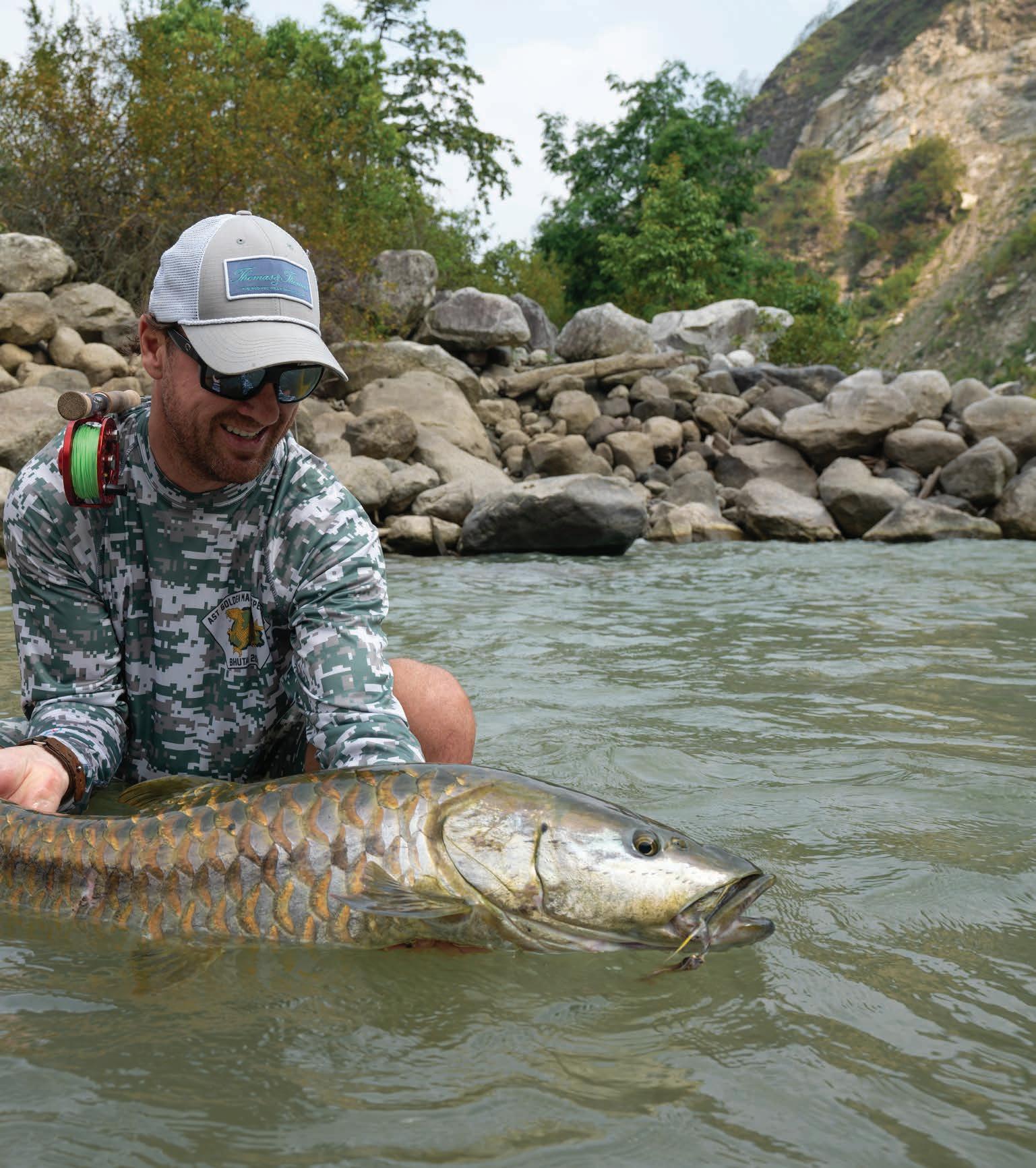



A familiar feeling of déjà vu struck as the fish surged across the river toward another set of rapids. We scrambled along the boulder-lined shore, chasing it as far as possible. Just as we thought we were about to lose it, the fish unexpectedly turned and swam straight toward us, settling into a back eddy. In disbelief, I dropped my camera, grabbed the net, and made a desperate lunge. The fish barely fit—it was massive.We carefully weighed it using two different scales, confirming a staggering 55lbs, allowing for the sling. It was the perfect finale to an unforgettable expedition. Over eight incredible days, we had landed 35 golden mahseer, including ten fish over 20lbs and two giants weighing 36lbs and 55lbs.
Bhutan had given us an adventure of mammoth proportions - one defined by breathtaking landscapes, humbling encounters, and the unparalleled thrill of chasing golden mahseer in the Land of the Thunder Dragon.
time of writing it was illegal – and only possible with special permission granted by the king.
Bhutan, a small, landlocked country in the Eastern Himalayas, is bordered by China to the north and India to the south, east, and west. Its diverse topography ranges from snow-covered peaks exceeding 7,000 meters (22,966 feet) in the north to subtropical plains in the south. The country is dominated by rugged, forested mountains and deep river valleys, which play a crucial role in shaping its climate and culture.
NB! Since the article was written, Bhutan has started to allow fly fishing for Mahseer. However, at the
The northern region features glaciated peaks and alpine meadows, home to rare wildlife like the snow leopard and blue sheep. The central region consists of temperate valleys and dense forests, supporting Bhutan’s traditional agriculture and ancient monasteries. The southern lowlands, part of the Indian subcontinent’s foothills, are covered in lush subtropical jungles, where elephants, tigers, and golden langurs roam.








Bhutan’s major rivers, including the Drangme Chhu, Puna Tsang Chhu, and Wang Chhu, originate from the Himalayas and flow southward, carving dramatic gorges before joining India’s Brahmaputra River. These waterways are vital for hydroelectric power, Bhutan’s largest export.
Bhutan has a population of approximately 800,000 people, making it one of the least densely populated countries in the world. The majority belong to the Drukpa ethnic group, with smaller communities of Nepali-speaking Lhotshampa and indigenous tribes in the south. Bhutanese society is deeply rooted in Mahayana Buddhism, which influences everything from governance to daily life. Prayer flags flutter across mountain passes, and dzongs (fortress-monasteries) serve both as religious centers and government offices.
The capital, Thimphu, is Bhutan’s largest city and the political and cultural hub. However, unlike most capitals, it has no traffic lights— local authorities believe that traffic flows better under the guidance of uniformed officers. Other major towns include Paro, home to Bhutan’s only international airport, and Punakha, the former capital, known for its stunning riverside dzong.



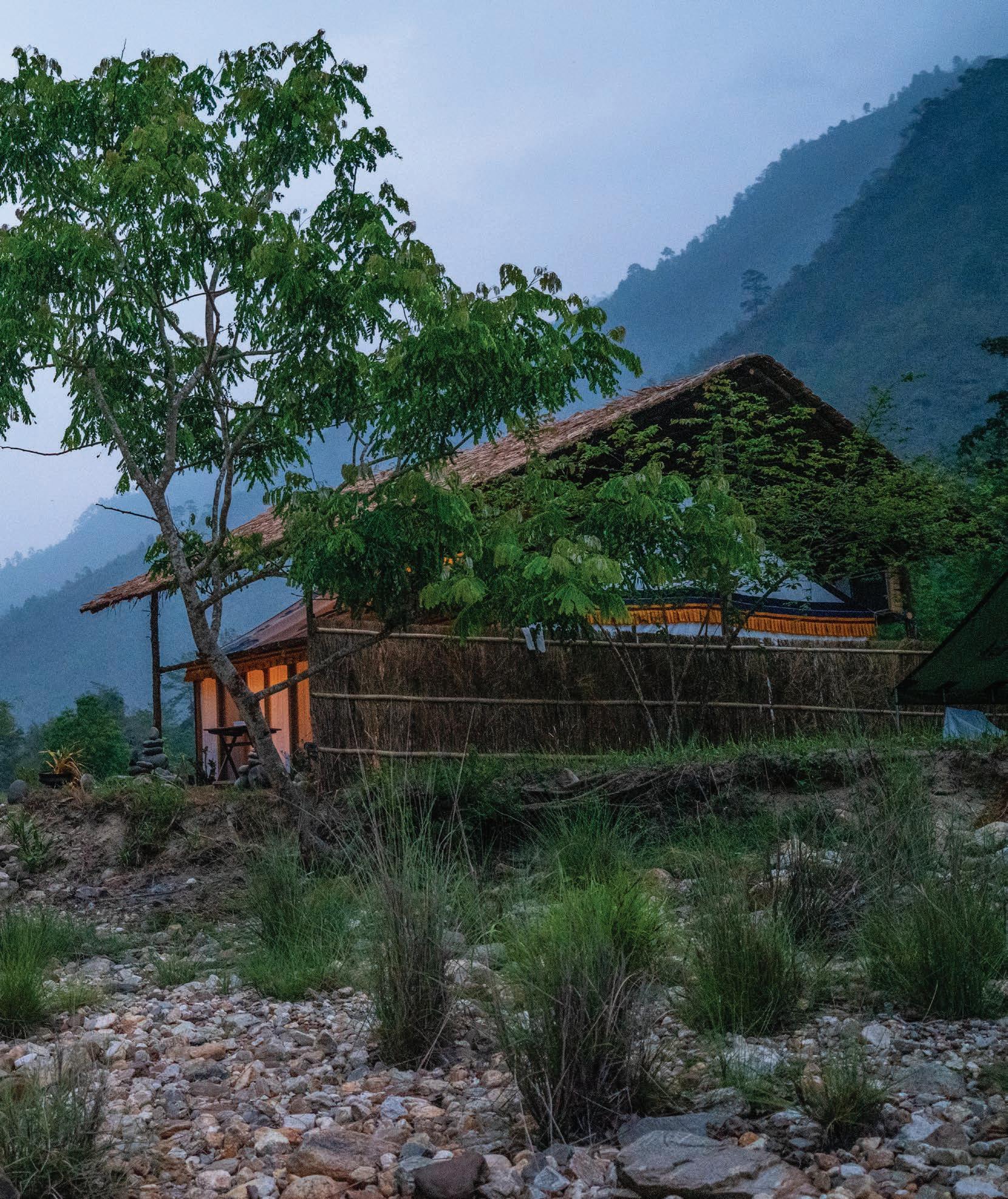

Bhutanese people follow a philosophy of Gross National Happiness (GNH), prioritizing well-being, cultural preservation, and environmental sustainability over economic growth. The country maintains a strong commitment to conservation, with over 70% of its land covered in forests and a constitutional mandate to keep it that way.
Bhutan’s remote location and strict tourism policies make it a unique destination that requires careful planning. The only international airport, Paro Airport (PBH), is served by just a few airlines, primarily Drukair and Bhutan Airlines.
Since there are no direct flights from Europe, travelers typically transit through one of the following Asian hubs: New Delhi, India (DEL) – Frequent Drukair flights connect Delhi to Parom, Bangkok, Thailand (BKK) – One of the most popular transit points, with daily flights to Paro, Kathmandu, Nepal (KTM) – A short but scenic flight over the Himalayas to Paro, Singapore (SIN) – A longer
route but an option for Southeast Asia-based travelers, or Kolkata, India (CCU) – A convenient gateway with frequent flights.Most visitors must arrange their trip through an authorized Bhutanese tour operator, as independent travel is not allowed. A daily tourist tariff applies, which covers accommodation, meals, transportation, and a licensed guide. This policy helps control visitor numbers and ensure sustainable tourism.
Once in Bhutan, travel within the country is typically by road, as domestic flights and helicopter services are limited. The mountainous terrain means that even short distances can take several hours by car. However, the journey is always breathtaking, with winding roads revealing stunning valleys, ancient monasteries, and pristine rivers.
Bhutan’s seclusion and commitment to preserving its culture make it one of the world’s most fascinating travel destinations - where ancient traditions, untouched nature, and spiritual depth converge in the heart of the Himalayas.



Nestled on the scenic Faro River in Cameroon, Gassa Camp has emerged as one of Africa’s most iconic fly fisheries. Managed by African Waters, this premier destination offers adventurous anglers a rare opportunity to cast for legendary Nile perch, three unique tigerfish species, the elusive Niger barb, and the remarkable large-scaled tetra, along with a wide variety of other fish. Over the past six years, Gassa Camp has redefined African fly fishing— creating unforgettable encounters with diverse species against a backdrop of stunning wilderness.
Join us for the fishing adventure of a lifetime at Gassa Camp, where every cast holds a new story.



By THE EDITORIAL STAFF

The Baltic salmon is facing one of its biggest challenges yet—a dramatic decline in wild populations due to poor fisheries management, industrial fishing, and environmental threats. In response to this crisis, Free Falling was created as a follow-up to Home Rivers Recycled, aiming to raise awareness and inspire action. In this interview with Lars Munk Lauritsen – from UndefinedFlyFishingProject.com, we discuss the background of the film, the lessons learned, and the urgent steps needed to protect this iconic species before it’s too late.
What’s the background for the film you’ve just released?
Approximately three years ago, Emilie and Ted decided to create Home Rivers Recycled, a film that explores Emilie’s love for fly fishing, her role as a mother, and her riverside life— marked by little sleep, embracing what nature offers, and the dream of catching a big Baltic salmon. The film also highlights the success story of Baltic salmon, showcasing what can be achieved through proper management of wild salmon populations. It illustrates improvements in Swedish river fishing between 2013 and 2021 and emphasizes how having a river to call home becomes a vital part of one’s life and lifestyle.
The film was originally set to have a follow-up in 25 years, but due to
a significant decline in wild Baltic salmon stocks in 2023 (and 2024), we decided to fast-track the sequel, Free Falling, to raise awareness about this urgent issue.
What was the most important lesson learned during the film project?
That’s a tough question, but personally, I learned the importance of maintaining a hopeful mindset. After about three weeks of fishing in 2023, I experienced a minor depression over the salmon’s future, which diminished the joy of fishing for me.
I felt deeply saddened by the uncertainty surrounding salmon populations, the indifference of politicians, and the potential impact on future generations’ experiences.



Through reflection and discussions with Ted, Emilie, and fellow fishers, I realized that my focus had been too narrow—centered on catching fish rather than understanding the bigger picture. As I head into the 2024 season, I’ve adopted a more open mindset, choosing to enjoy my time by the river while raising awareness about these pressing issues.
How have you been affected by the decline in salmon runs in Sweden (and beyond)?
The decline of both Baltic and Atlantic salmon has negatively impacted lodges, camps, entire river valleys, and the local economy—including stores, gas stations, and other businesses—due to fewer fishermen visiting. This has led to reduced revenues and a general decline in well-being among salmon fishers, conservationists, and communities along the rivers.
Politicians need to recognize the wider economic implications—not just local revenue losses but also the broader ecosystem, which includes the tackle industry, travel companies, restaurants, and accommodations.
My primary concern is that decision-makers will continue to overlook these urgent issues, potentially leading to the disappearance of Baltic salmon. However, I refuse to believe this will be the outcome. I genuinely believe there is still time to positively influence the future of both the salmon and the Baltic Sea.
Right now, many things are going in the wrong direction, but I also sense a counter-reaction. Hopefully, this marks the beginning of a new and necessary shift in awareness and action.
How would you explain the decline of Baltic salmon?
To keep it brief, the main contributing factors are:
• Trawlers catching sprat and herring (along with bycatch) for the farmed salmon and feed industry.
• A short-sighted management system based on smolt production (MSY) instead of focusing on returning adult salmon.
• A lack of a holistic approach to managing the Baltic Sea.
• Pollution in the sea.
• Global warming.
Other factors also play a role, but in my opinion, these are the primary drivers of the decline.






Which factors need to be addressed for Baltic salmon to recover and repopulate the rivers?
One critical issue is the current management approach, which focuses on the number of smolts entering the sea. This method is both problematic and short-sighted. The MSY (Maximum Sustainable Yield) target of 75% smolt capacity does not adequately account for the fishing that occurs in rivers.
While this target may result in more salmon than in previous decades, it does not ensure sustainable populations in both river and sea environments. A lower number of returning adults leads to a higher smolt survival rate, meaning fewer adults are needed to maintain smolt production at 75%. For example, if the Torne River has 45,000 returning spawners, it can potentially produce 2 million smolts, which may seem sufficient. However, the river could sustain 300,000 returning adults, which would significantly benefit river ecosystems and local communities.

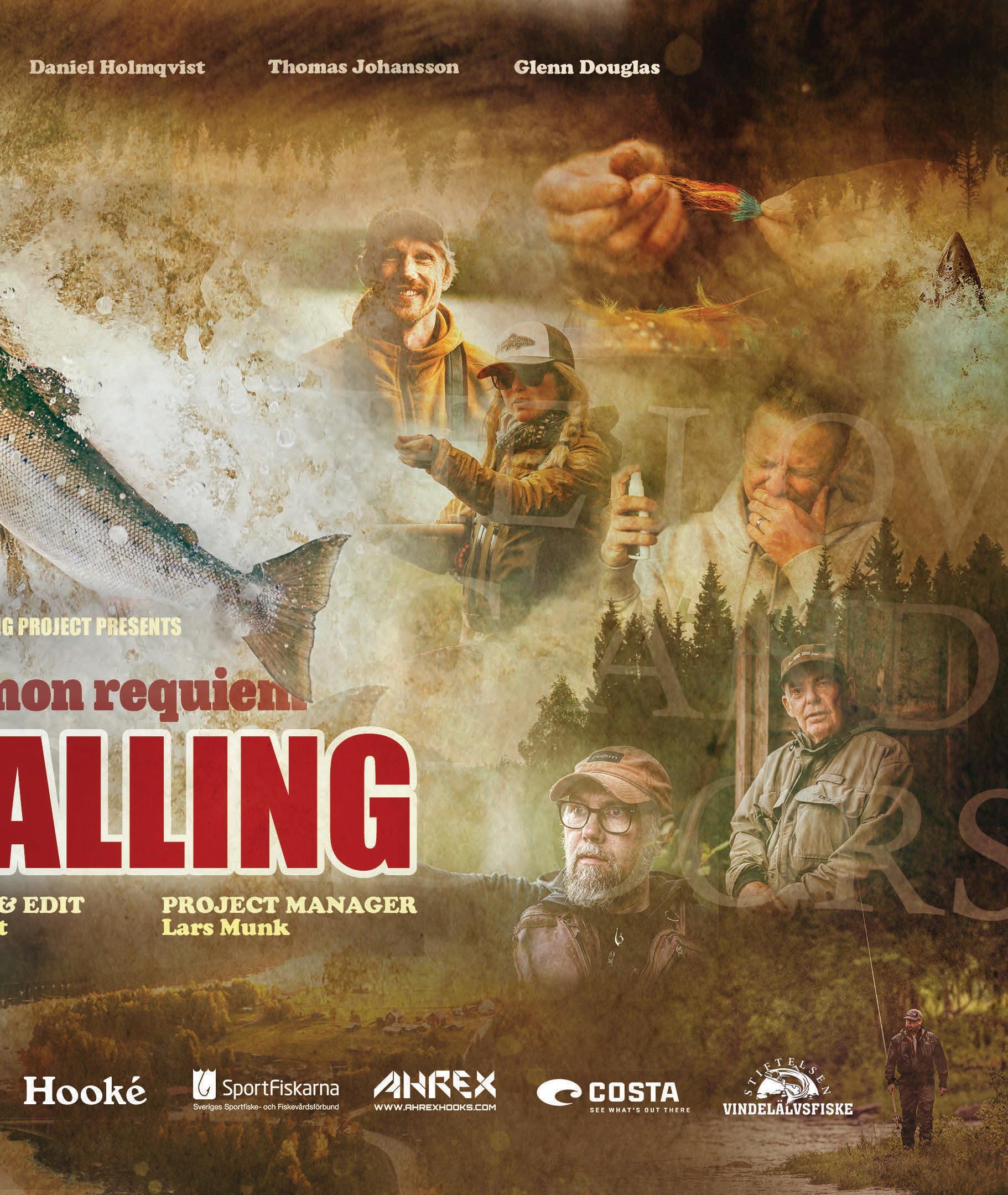
Step 1: We need a management approach that prioritizes a minimum number of returning adults to ensure river systems thrive. Sustainable fisheries must consider both river and sea environments, balancing the interests of local fishers and commercial fishing industries. Additionally, the use of wild fish stocks for feed in non-sustainable farming industries must e stopped.
Any key advice for people who want to get involved in protecting and preserving Baltic salmon?
While we don’t claim to have all the answers, as passionate fly fishers with a deep connection to nature, we encourage everyone to take action. Spread awareness—talk to your neighbors, classmates, and co-workers. Share valid information on social media, engage with local politicians, or create content like films and articles. Every effort, no matter how small, contributes to the cause.




Is there any hope?
Absolutely! There is plenty of hope, and we can make a difference. Real change happens when people come together, advocate passionately, and maintain a strong connection with nature. By raising awareness and inspiring action in our communities, we can create a brighter future for Baltic salmon.
Even though the situation is dire, we must remember that Baltic salmon made a remarkable comeback from near extinction in some rivers during the 1990s. Let’s hope history repeats itself— with the right actions and a commitment to responsible, holistic management.
Hope thrives in our collective efforts—so let’s keep talking, keep fishing, and give the salmon the voice it deserves!


For many, fly fishing is just a sport. For others, it is an art, a way of life, and a means of connecting with nature on the deepest level. Few embody this passion as profoundly as Alexis Pageau - photographer, videographer, TV host, and lifelong angler. From childhood days spent exploring the river behind his home to traveling the globe in pursuit of the perfect cast (and catch), Alexis has carved out a unique career built around his love for fly fishing and the wild places it takes him. In this exclusive interview, Alexis shares insights into his journey, the moments that have defined him, and his relentless pursuit of exploration - both behind the camera and on the water.
By THE EDITORIAL STAFF


BIO//
Full name: Alexis Pageau
Born: September 11, 1990
Nationality: Canadian
Occupation: Photographer, TV Show Host, Videographer
Instagram: www.instagram.com/alexis.pageau
Facebook: www.facebook.com/alexis.c.pageau
Website: www.alexispageau.com
How did you get started fly fishing?
I started fly fishing at a very young age, in the river that runs behind my family’s home. As a child, I struggled with strong ADHD, and the only place where I truly felt at peace was in nature. Fly fishing became the first passion that made me realize I could be good at something when it genuinely interested me. The pursuit of a fish would channel all my scattered thoughts, allowing me to focus on a simple yet incredibly complex goal: capturing that fish. It was in those moments that I felt truly centered and connected to the world around me.
What was it about fly fishing that intrigued you in the first place?
What intrigued me about fly fishing was the sense of adventure and freedom it brought. It was the thrill of embarking on a quest with an outcome that was completely unknown and highly uncertain. I was also drawn to the sense of responsibility it gave me. As a kid, you’re always being told what
to do, and with my condition, I was told even more often than others. But on the river, it was my kingdom. It was where I could make my own decisions and truly feel in control. It was also where I learned to take responsibility for my own mistakes and to never take anything for granted because nature is unpredictable. This experience humbled me and gave me a better understanding of the real world.
What’s your fondest fly fishing memory?
My best fishing memory, or at least the most vivid one, took place in Sweden during my first season as a host on the TV show, Hooké. I had been contacted eight months earlier by Hooké because they were looking for a new host. During all that time, I didn’t want to fully rejoice in the news, fearing it might be taken away from me. But in the middle of northern Sweden, on one of the best salmon rivers in the world, as I was making my cast, I was alone and finally took the time to savor the moment and realize that my life would never be the same again.
Overwhelmed with emotion, I cried tears of joy, knowing that from that moment on, I was going to live the way I had always wanted, making a living from my passion for fly fishing. That day, I didn’t catch a fish.
What are the driving forces that keep you going as a fly fisherman nowadays?
The driving force that keeps me going as a fly fisherman today is still the same feeling that has driven me for over 25 years, but now my playground has simply expanded. When you fish a river, a lake, or the sea, as a fisherman, you’re always pushed to explore further, to see what’s around the next bend or in the next pool. It’s that spirit of exploration and discovery that still drives me today. It’s also the feeling of not knowing, the curiosity to better understand and decipher the ever-changing, volatile code of nature.



As a photographer, what are you most looking for in fly fishing?
For a long time, my focus was on capturing beauty - creating the most stunning images possible, always with respect for the fish and the goal of inspiring others toward ethical and responsible fishing practices. My aim was to educate and inspire through these beautiful visuals. While I still hold these goals dear, my focus has evolved. Now, I’m drawn to the authenticity of fleeting, magical moments. Photography, for me, has become a way to preserve these moments in time, keeping them alive when memories alone start to fade.
What’s your most important tip for improving the quality and relevance of fly fishing pictures?
Once you’ve mastered the basics of photography and composition, the most important factor becomes the choice of location. Since we work in natural environments, we are at the mercy of what nature provides. It’s crucial to anticipate the action be-
fore it happens, positioning yourself accordingly to capture those key moments from the best angles. Many of the fish we catch are fragile and don’t have the luxury of posing for us, so being prepared and knowing how to anticipate the action is essential.
Equally important is storytelling. Capturing a unique moment is far more compelling than taking a technically perfect photo with a beautiful subject. In the end, the story behind the image always takes precedence over its beauty.
What’s your relationship with Hooké?
Hooké introduced me to the world of fly fishing and was instrumental in shaping my career as a photographer, host, and TV presenter. For that, I will always be deeply grateful. We continue to work together on targeted projects, such as hosted trips and various photo or video ventures. However, I left the company three years ago to launch my own production company because, true to who I am, I felt the need for more exploration and independence.



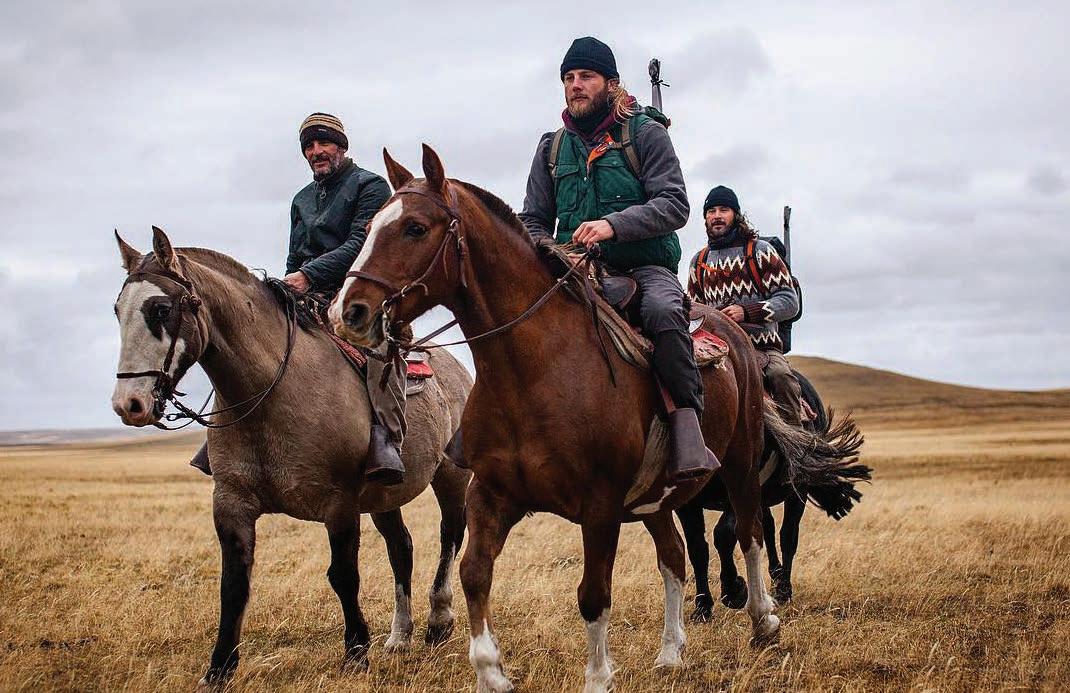



What’s your favorite destination to fish -and why?
Without a doubt, New Zealand is my favorite place to fish. It’s a wild, untamed land where fishing is a complex and rewarding challenge, set against some of the most breathtaking landscapes you can imagine.
In New Zealand, sight fishing is king, and every fish, no matter its size, feels like a true trophy because of the skill it takes to catch it. It’s also a place of immense grandeur, where the choices and possibilities seem endless.
When you’re there, you feel completely alone in the world, at the far end of the planet - it’s like being in a dream.





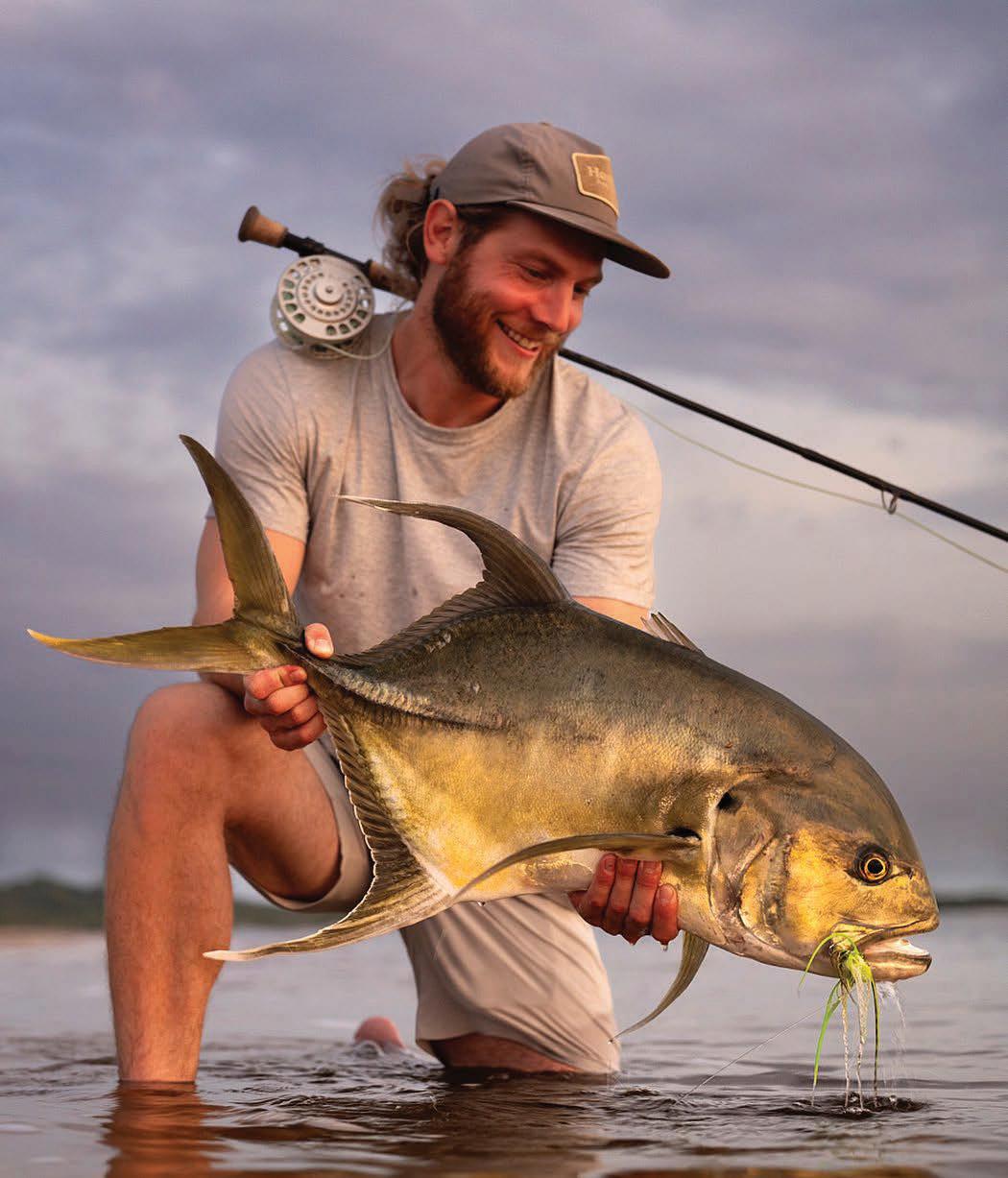





What are your ambitions as a fly fisherman and as a photographer?
As a fly fisherman, my ambitions have evolved into a deep desire to discover even more new and uncharted waters, pinpointing the best fly fishing destinations around the globe. I’m passionate about documenting these extraordinary places and sharing them with those who accompany me on these adventures.
As for photography, my mission is to continue creating authentic content that not only captures the beauty of nature but also inspires others to explore and protect it. I want my work to ignite a sense of wonder and responsibility in people, encouraging them to discover the natural world’s treasures and to commit to preserving these precious environments for future generations.
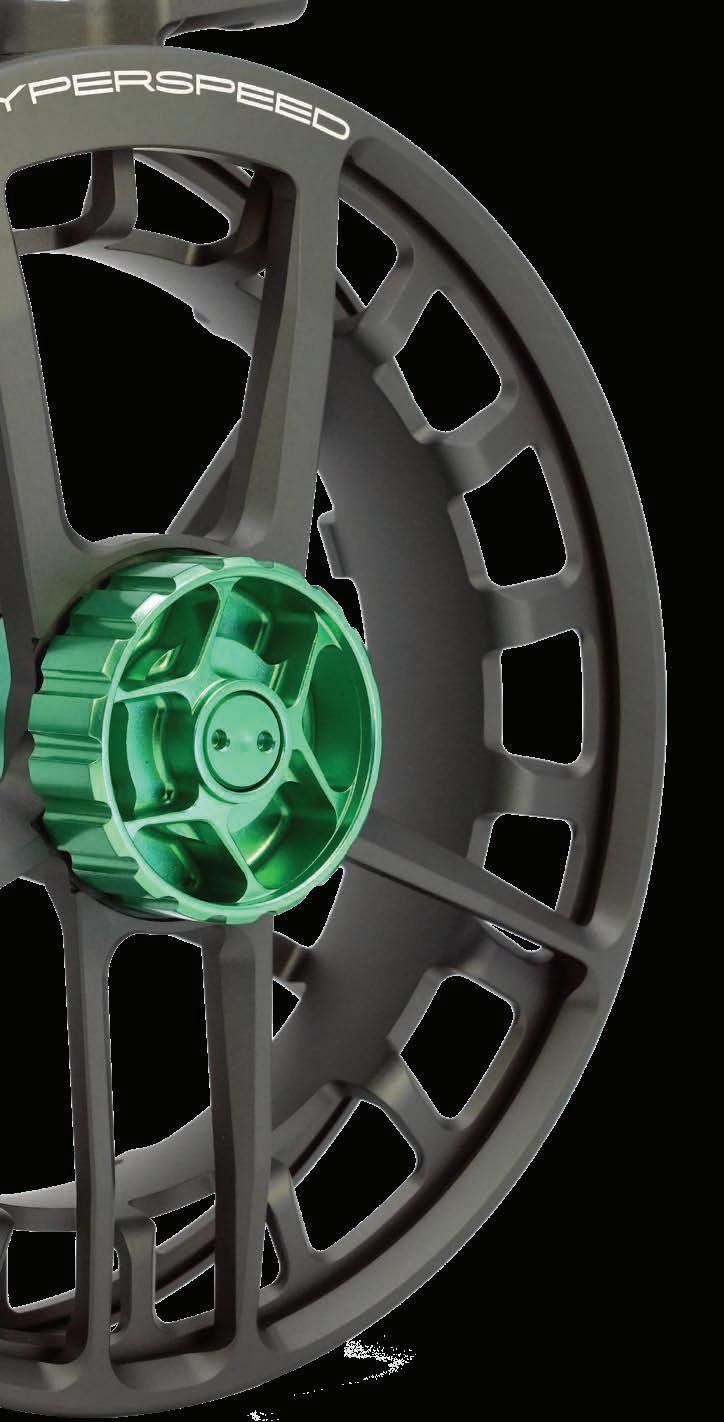









Buckle up. As we’ve said - the performance benchmark for a fly reel is retrieve rate per ounce. There’s no downside to high retrieve rate other than the extra weight. Imagine an 8 weight reel the diameter of a 12, envision gobbling up 14” of line per rotation. Now stop wondering and try to keep up with the Hyperspeed M8. Coming in at less than an ounce heavier than its Litespeed M8 counterpart, this radical design maximizes line pick up unlike any reel we have ever dreamed up. Every inch of the frame and spool has been meticulously CNC machined with even material distribution along critical load paths. Ensuring unrivaled strength, stability, and lightness despite its impressive size. So light you might forget it’s there, but commanding enough to demand attention. Find a new gear with this reel that’s primed to keep pace with even the fastest fish you can find.

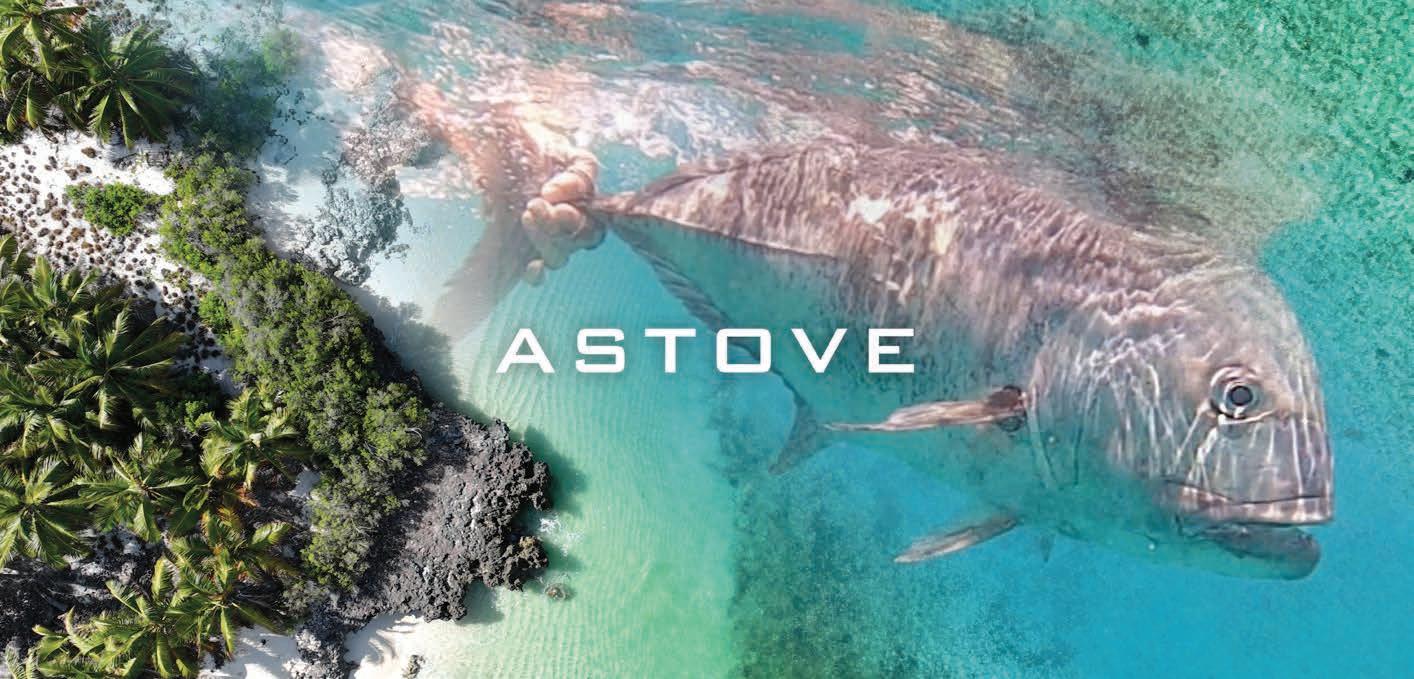
By IN THE LOOP MAGAZINE
Astove Atoll’s shallow lagoon, jagged coastline and endless flats surrounded by sheer drop-offs provide unique and versatile hunting grounds for a myriad of gamefish emblematic of the vast Indian Ocean. Besides GTs, Astove Atoll boasts trophy-sized bonefish, bluefin trevally, triggerfish, barracuda, milkfish and Indopacific permit. And if one ventures offshore, one can catch yellowfin tuna, dogtooth tuna, wahoo, groupers, sailfish and much, much more – just meters from the coral reef edge. Astove Atoll is managed by Alphonse Fishing Co. For more information, please refer to: www.alphonsefishingco.com




Eden Bleu Hotel
Just 5 minutes from the International and domestic airport!










New Zealand by some of the most avid and experienced trout fishermen, Primal Fly Rods and Fly Lab Fly Reels epitomize performance and value for money. More info


Art and fly fishing may seem like two distinct passions, but for Charles Hicks, they intertwine seamlessly. Based in Atlanta, Georgia, Charles balances a full-time career in medical sales with his love for both fly fishing and art. His detailed, marine-inspired illustrations have captivated fellow anglers and art enthusiasts alike, gaining recognition in the world of fishing-inspired artwork. In this interview, he shares how his passion for fish fuels his creativity, how fly fishing and art complement each other, and what’s next for him in both fields.
By THE EDITORIAL STAFF




Can you tell us a little about your background, how you got into art, and how your fly fishing journey began?
My name is Charles Hicks, and I live in Atlanta, Georgia, where I work fulltime as a medical sales representative. In my free time, I’m an artist and a fly fishing connoisseur. I was born and raised in a fishing family, but the world of fly fishing was foreign to me until I was a teenager. My older brother, James, got me interested in the sport after taking a few trips out west to Yellowstone National Park. After catching my first trout on a dry fly, I was hooked. Over the years, I’ve been fortunate enough to fish in some amazing locations and chase after extraordinary fish.
On the art side, I’ve always been an artist at heart. Ever since I was a little boy, I’ve loved creating. I come from a long line of artists, and I’m proud to carry on that tradition in my family. Throughout my years in high school and college, no subject brought me more joy than drawing marine life. I’ve always been fascinated by the ocean and fish, and as my passion for fly fish-
ing grew, so did my passion for illustrating sought-after sport fish.
Who or what inspires you to create artwork?
The biggest inspiration for my art has been and always will be my passion for fish. I’ve been fascinated with marine life ever since I was a kid, and the ability to create art that others enjoy fuels my passion even further. I also draw inspiration from some incredible marine artists I’ve followed for years, including Paul Puckett, Yusniel Santos, Jorge Martinez, and Derek DeYoung.
What compelled you to paint fish and fly-fishing motifs?
I’ve been drawing since I was a kid, but as life got busier in college, art took a back seat. It wasn’t until my brother and I took a trip out west to Missoula, Montana, that I was re-inspired to start posting my artwork again. For some reason, the fish we caught on that trip reignited my creativity. I initially focused on trout-specific works but have since shifted more towards saltwater species.

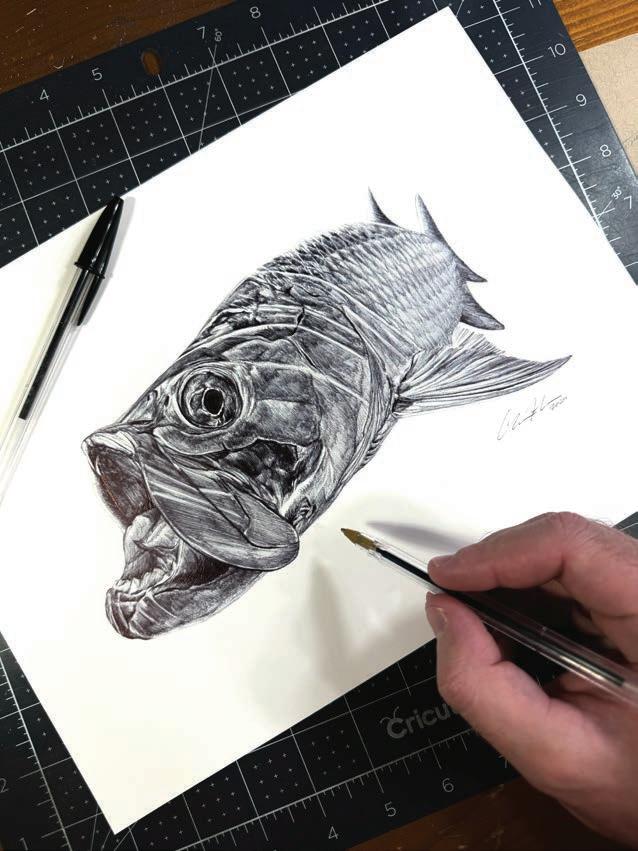
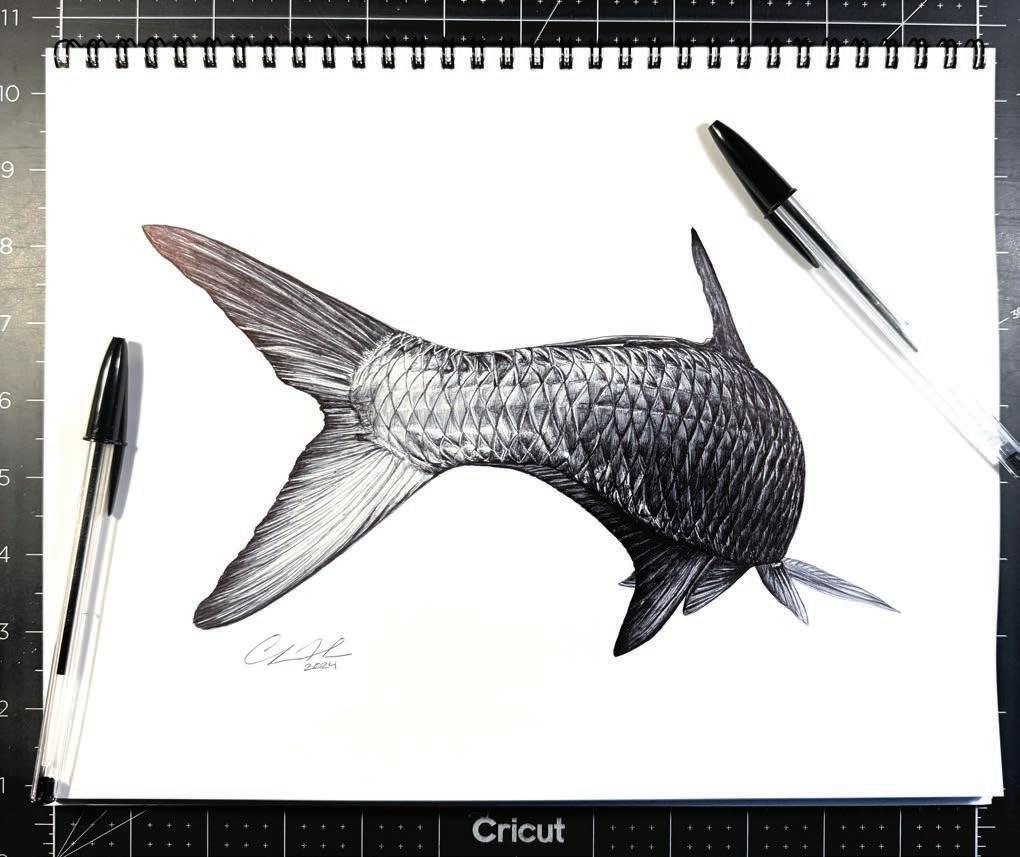


To be completely honest, I never expected my art to take off the way it has. The responses and messages I get after posting each new piece motivate me to keep creating. I love having the ability to make works that fellow fly anglers appreciate.
What is it about fly fishing that intrigues you?
Fly fishing intrigues me because it presents both a challenge and a reward. It’s the most natural way to target any fish species but also the most difficult.
Throwing feathers and string at a fish is hard enough—convincing it to commit and eat them sounds like lunacy, but it works.
Ultimately, nothing compares to the feeling of landing that fish you’ve been chasing for weeks, months, or even years. The thrill of catching a trophy fish on conventional tackle is great, but achieving it with a fly rod is truly remarkable.






How do you split your time between fly fishing and painting?
Currently, fly fishing and art revolve around my full-time job. I find time to draw after work, and my weekends are when I get out on the water. Living in Atlanta has its benefits, but fly fishing opportunities are somewhat limited. Fortunately, we have great fisheries nearby, like the Chattahoochee River and Lake Lanier, though optimal fishing windows depend on the season.
As an artist, I think it’s important to balance fishing and creating. Time spent on the water fuels my creativity and passion for drawing.
If you could choose freely, would you fly fish more or create more artwork?
In an ideal world, I’d love to chase fish all day, every day, but unfortunately, that isn’t feasible right now. Once I’m older and working less, I hope to have a healthy blend of fishing and creating. As I’ve mentioned, experiences on the water are what drive me to create.
Do fly fishing and making artwork complement each other—and if so, how?
Absolutely. My art career didn’t take off until I truly embraced fly fishing. That short trip to Missoula, Montana, during my junior year of college inspired me to start creating and sharing my work.
Since then, I’ve refined both my fly-fishing and artistic skills in parallel. Has fly fishing helped you become a better artist—or vice versa?
Without a doubt. My passion for fly fishing has pushed me to improve as an artist, and my art has deepened my appreciation for fly fishing. Both require immense attention to detail, patience, and creativity.
Like anything in life, practice makes perfect. If you compare my current work to my earlier pieces, you’ll see major improvements in composition, detail, and color choice—the same goes for my fly fishing skills.


What are your aspirations as a fly fisher?
Like most anglers, I aspire to travel the world and catch incredible fish. I also want to incorporate art into the experience. Fly fishing offers so much—it takes you to exotic places, introduces you to different cultures, and connects you with amazing people. By the time I’m old, I hope I can say I’ve done all that.
Do you have any exciting projects coming up, either in fishing or art?
Art has been a bit slow in 2025 due to work, but I have a few projects in the works. One is a new BiC pen piece featuring a species I haven’t tackled before—it’s been more challenging than I expected, but it’s coming along. I also have a few new toned-paper pieces in progress, though I can’t share details just yet.
On the fishing side, right now is prime time in North Georgia for catching striped bass on the fly. The season has thrown some crazy weather at us, making fishing tough, but I’m hoping for some good catches as the weather warms.




Any advice for fellow fly fishermen who aspire to create fish art?
For anyone interested in blending fly fishing with art, my advice is simple: have fun with it and draw what you love.
Push your boundaries and experiment with different mediums until you find one that speaks to you. My main tools are pen and colored pencils, but I enjoy trying others for a fresh perspective.
Patience is also key. Just like fly fishing, art can be frustrating, but with trial and error, anyone can improve. If anyone has specific questions about creating art, feel free to send me a direct message!




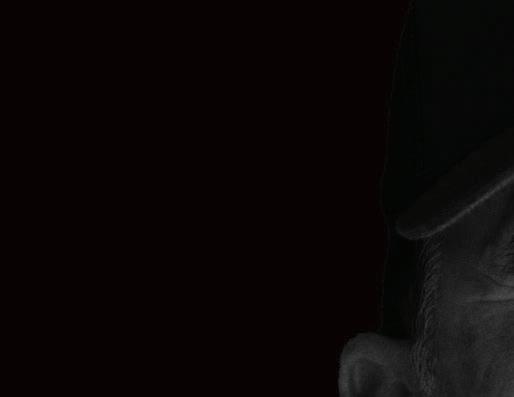
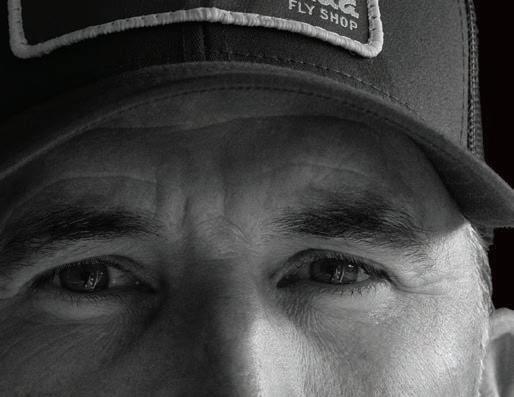
“


“ The new Magnitude clear floating line comes out of the bucket clean. No tangles. And, for my clients, that’s the difference between a heart attack and a high five.
-Dustin Huff














Duracoat

Specialized dual-polymer design optimizes line stiffness, slickness, and abrasion resistance while significantly reducing line memory and tangles.




Clear Floating Technology uses naturally buoyant polymers for the ultimate in stealthy presentation and best-in-class durability.
EST +
EST+ - proprietary slickness additive that provides unmatched durability, smoother shooting, and eco-friendly performance.







The hatching of large mayflies, Ephemera danica, is often considered the highlight of the Danish brown trout fishing season. Experienced dry fly angler John Petermann shares a few basic tips and introduces three favorite flies that he always keeps in his early summer fly box—along with one wildcard.
By PETER LYNGBY

The dream of hitting one of the year’s first big mayfly hatches lives in every fly fisher’s heart. Days when the majestic insects fill the air, and the river’s brown trout frenzy in a feeding spree— even the largest and wariest fish abandon caution and join the feast.
However, there are also days when fishing is challenging, or the anticipated mayfly hatch fails to occur. What should a beginner do in these situations? How do you plan for optimal conditions, and what if the fish turn their attention to other food sources?
To answer these questions, we turned to John Petermann, an experienced dry fly angler who has fished Danish mayfly seasons for over three decades. Petermann is a walking encyclopedia of entomology, the study of insects, and his enthusiasm for their Latin names and life stages is infectious. He is also deeply passionate about fly tying and the many ways to imitate insects. In this article, however, we focus on the basics of mayfly fishing and some simple yet reliable flies for the season.
The key to successful mayfly fishing is timing the hatches, and Petermann shares his insights on when and where to go.
“Most of my mayfly fishing takes place at the Kongeåen and Gudenåen rivers, which have the largest populations of mayflies. Both rivers have angling associations offering memberships or day passes. The mayfly season typically runs from mid-May to mid-June. The best fishing occurs during the first solid hatches in May, although the largest swarms usually appear in June.
“Early in the season, fish are less selective and readily take mayflies. Later on, they can become more cautious and picky. If I had to choose just one trip, I’d plan it for the last week of May.
“That said, finding mayfly hatches isn’t particularly difficult. Warm days with an approaching low-pressure system are ideal. Look for those days when thunderclouds roll in, the sky turns purple, and the air becomes calm and humid.
Modified French Partridge (John Petermann’s Version)
Hook: Ahrex FW571, size 4–8 (primarily size 6)
Thread: Veevus 10/0, brown
Tail: Elk mane, natural
Body: Fly-Rite, brown drake yellow no. 34
Body Hackle: Rooster feather, dark dun
Wing Hackle: Swiss CDC Ultra Select XL, dark grey khaki
Front Hackle: French partridge feather, natural


This ‘calm before the storm’ is excellent mayfly weather, and hatches often explode on such evenings.
“While sunny days can be pleasant, insect activity usually slows, and the fish are much warier in bright sunlight,” warns Petermann.
The largest mayflies have wingspans of nearly five centimeters, requiring a substantial dry fly to imitate them. However, Petermann notes that less can often be more.
“Many beautiful, intricate mayfly patterns have been tied over the years. When imitating the largest mayflies—the females—you often see extended body designs. My recommended fly, a heavily modified version of the French Partridge, is simpler. It imitates the smaller, more brownish males and has several advantages: it’s easier to tie, casts better, and hooks fish more effectively.
“For large brown trout, it’s easy to inhale a massive insect or imitation. However, not all trout are that size. I’ve found that extended-body flies often make hooking fish more difficult.
“My fly can be fished as a dun (floating on the surface) or a spinner (lying in the surface film). If needed, I trim the underside to create the spinner profile. It’s an all-around mayfly imitation, even though it has diverged significantly from the traditional French Partridge pattern. I replaced the classic yellow floss with a body hackle and added CDC to the wing for better floatation and movement.
“I regularly vary its size and color to match both males and females,” Petermann explains.
The mayfly season from mid-May to mid-June isn’t a continuous feast, so anglers should be prepared for other scenarios.
“Don’t forget the other insects during the mayfly season. Fish can switch to alternative food sources depending on hatches, which may vary along the river due to temperature differences. Smaller mayflies are abundant, and trout can be surprisingly selective.
“My CDC Upright Spinner imitates various mayfly species, including yellow ones, which are often less vibrant in their spinner stage.





A brown spinner can cover many egg-laying mayflies, but having a few small yellow ones in your box ensures readiness. I add a few white Fluoro Fibre strands to the CDC wing to mimic the reflective quality of insect wings in the light—just a few, though, as too many wings can look unnatural.
“Another must-have is my Floating Universal Nymph, which works well when trout bulge just below the surface. In the evening, they’re likely feeding on spinners; during the day, it’s often nymphs near the surface. This versatile pattern imitates several mayfly species and can be fished on or just below the surface.
“Lastly, always carry a few hawthorn fly imitations. These can be game-changers when trout suddenly switch to explosive strikes. Hawthorn flies are poor fliers and often end up in the water, especially on windy days. I’ve experienced phenomenal fishing with them along the Kongeåen,” Petermann reveals.
Casting large mayflies requires some adaptation, especially for beginners.
Petermann recommends sturdy dry fly gear.
“For newcomers, I recommend a classic 9-foot rod in a 5-weight with a fly line that isn’t too short-headed, like the Scientific Anglers Amplitude Smooth Infinity. Large dry flies tend to twist the leader, particularly if the tippet is too thin. I use leaders with 0.18 mm tips.
“Try casting at an angle to the fish to avoid too much line drifting over it before the fly. Always aim for a dragfree drift. If the fish doesn’t take on the first cast, try again. If it still refuses, it might be spooked or you might need to change tactics.
“Watch the fish closely. If it stops feeding, stop fishing and give it a break. If the fish keeps feeding but ignores your fly, it’s time to switch patterns. Observing fish behavior is crucial for success.
“When everything aligns, mayfly fishing can be both thrilling and effective. Always handle brown trout with care, as they are precious. Use barbless hooks to make release faster and easier,” Petermann concludes.






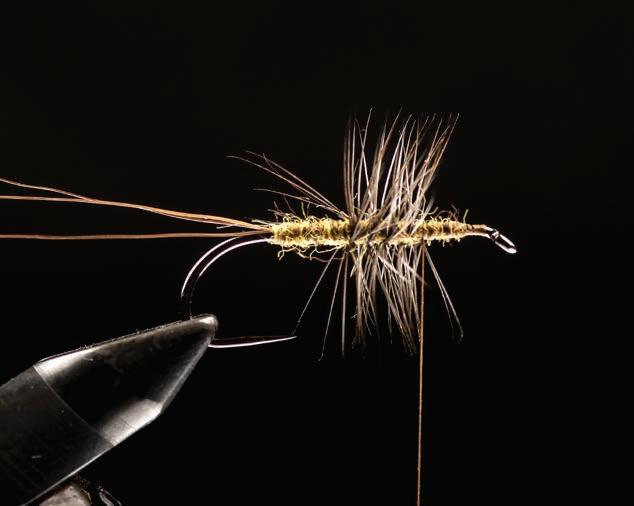







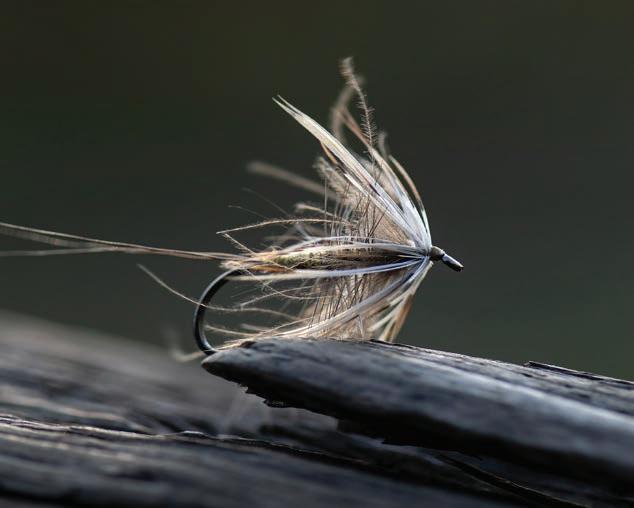


Session rods are high-performance hand-crafted fly rods that blend some of our most acclaimed design approaches with our latest materials and technologies.
Scott Fly Rod Company | Handcrafted in Montrose, Colorado
















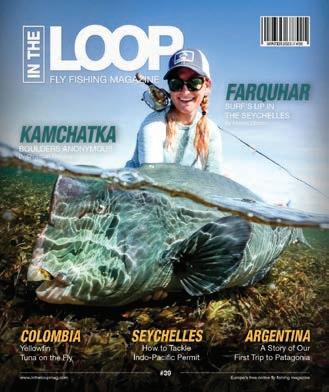
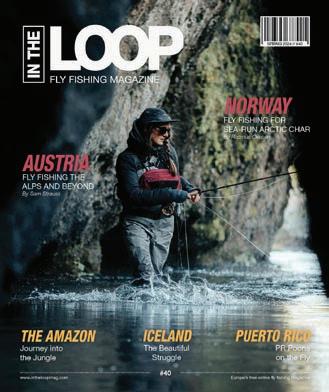



Join the fight to protect our oceans, lakes, and rivers, the pristine aquatic ecosystems across the globe and thei precious fish stocks. It’s an acutely important battle - and one that we simply cannot afford to lose!
Join the fight to protect our oceans, lakes, and rivers, the pristine aquatic ecosystems across the globe and thei precious fish stocks. It’s an acutely important battle - and one that we simply cannot afford to lose!




















